This page aims to provide a comprehensive reference of hotels in Lambton from 1864.
- Lambton Arms Hotel
- Gold Miners’ Arms Hotel
- Northumberland Hotel
- The Rose, Thistle, & Shamrock Inn
- Rose and Crown Inn
- Prince of Wales Hotel
- Red Lion Inn
- Lancashire Arms Hotel/Welcome Home Inn
- Marquis of Lorne Hotel
- Pine Apple Hotel
- Jesmond Hotel
- Royal Hotel
- Coal Miners’ Home Hotel
- Miners’ Arms Hotel
- Royal Oak Hotel
- Race Horse Inn
- Northern Star Hotel
- Commercial Hotel (1)
- Exchange Hotel
- Marquis of Midlothian
- Commercial Hotel (2)
- Reservoir Hotel
This list covers hotels that were located in the area of Lambton Municipal Council (1871-1938), which included parts of North Lambton and Jesmond.
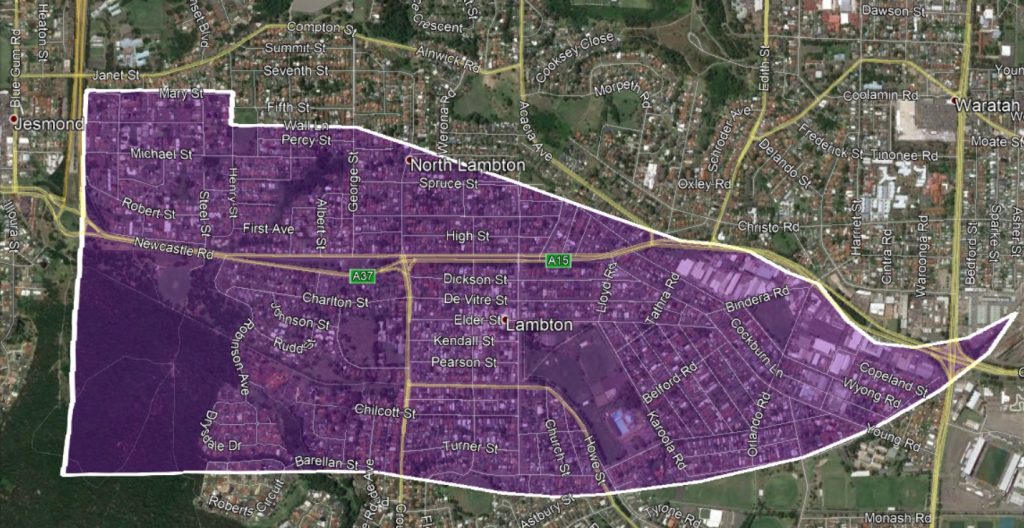
The map below shows the location of Lambton Hotels. The three hotels that are still operating are shown in green, historical hotels are shown in red. I have used the ‘drinking glass’ icon, where the location of a hotel is known, and a generic placemarker icon if the location is uncertain or unconfirmed.

In documenting the history of hotels it is important to understand the roles of owners, lessees and licensees. The hotel owner is the person (or company) that owns the land and buildings upon the land. The owner may then lease the buildings to another person (or company) for the purpose of running a business such as a hotel. The hotel licensee is the person who is granted a liquor license by the government and is responsible for adhering to the liquor regulations. Sometimes the owner and licensee are the same person, but sometimes the owner, lessee and licensee are three different entities. For example, in 1893 the Reservoir Hotel was owned by John Cox, leased to John and James Toohey, and the licensee was William Rutherford.
The history of hotels can also be confusing in that not only can the same hotel can different names over time, but sometimes different hotels can have the same name. For example, there were two different hotels in Lambton called the Commercial Hotel, one operating from 1880 to 1882, and a different hotel operating from 1888 to 2018. Sometimes a hotel name and license can be transferred to a different geographical location. For example, the Miners’ Arms Hotel first opened on Howe Street in 1887, but then moved to the adjacent block of land in Howe Street in 1881.
In the list below I have an entry for each hotel operating at a specific location. The hotels appear in order of the year they were first opened. Where a hotel has had multiple names, I have used in the heading the name that the hotel was known by for the majority of its operation.
A further complication is that the variant spellings of the names of licensees. Where there are multiple spellings of a name and the correct spelling is uncertain, I have included all the variant spellings, separated by a slash character. e.g. “Lackey/Leckey”. Note that in the lists of licensees I have only included names up to about 1970, as published information about licensees after this date becomes sparse.
A helpful resource in my research for this article was Appendix 2 of “The Story of Lambton” from the Newcastle Family History Society. However I did find a number of errors, omissions and confusions in their list of hotels and licensees. My intent for this page is to build on the work of that Appendix and provide a more accurate and comprehensive reference for the hotels and hotel licensees of Lambton.
Having said that, I am conscious that this list probably contains errors, omissions and confusions of my own, and so I would welcome any feedback or additional information that would improve this page.
A note about Colonial Wine Licenses:
Appendix 2 of “The Story of Lambton” includes an entry for “Lambton Hotel”, and then lists a number of holders of a Colonial Wine License. I have not included these in the list below, as a colonial wine license was not a hotel in the commonly recognised sense of a place to buy and consume alcohol, and provide accommodation. A Colonial Wine License merely provided for the retail sale of locally produced wines and ciders, under very limited circumstances, with the holder of a license able to …
… sell and dispose of on the premises in such license specified wine cider or perry the produce of fruit grown within any Australasian colony in quantities not exceeding two gallons and not containing a greater proportion than twenty-six per cent, of proof spirits but only between the hours of seven in the morning and eleven at night.
Sec 26 of Licensing Act of 1882.
Lambton Arms Hotel (1864-1920)
Located on the south west corner of Pearson and Grainger Streets.

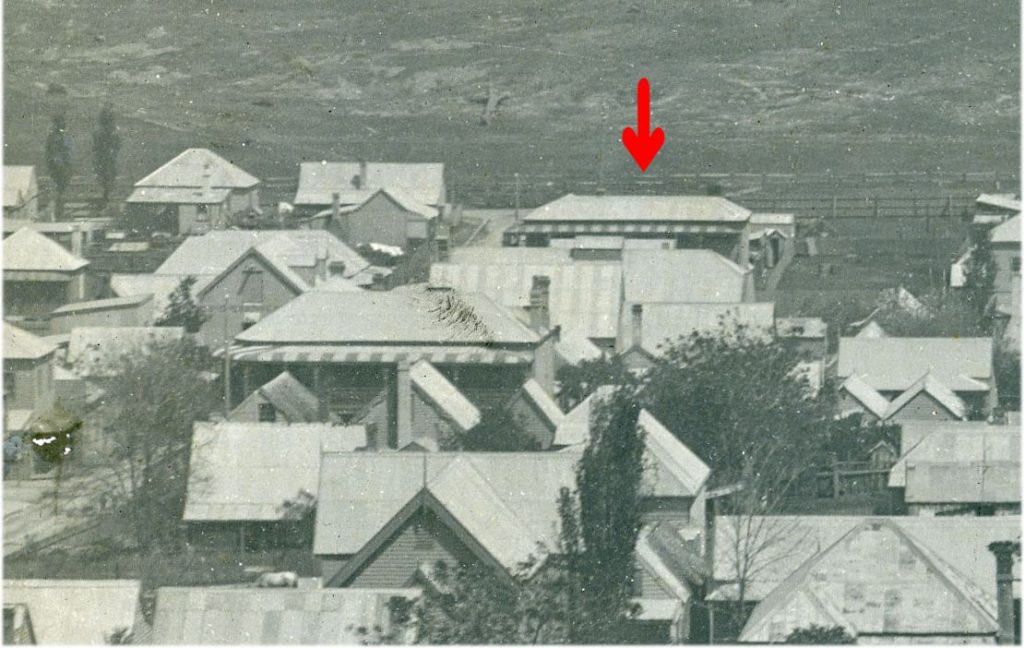
Robert Cairns purchased lots 13 and 14 of Section K in the Lambton township in June 1864. (See Vol-Fol 5-115). This was the very first block of land to be sold in the town.
A hotel building must have been quickly erected, for on 29 October 1864, the Newcastle Chronicle and Hunter River District News reported that …
A ball and supper was given at the “Lambton Arms,” by the landlord, Mr. Cairns, on Tuesday evening, at which a great number of persons were present, and enjoyed themselves.
The hotel was badly damaged by a fire in January 1888, but quickly replaced by a new wooden building by April 1888.
The hotel traded until 1920 when it was closed, and the license transferred to the Hotel Mayfield in January 1921. A newspaper article in 1938 refers to the Lambton Arms hotel building as having been “recently demolished”.
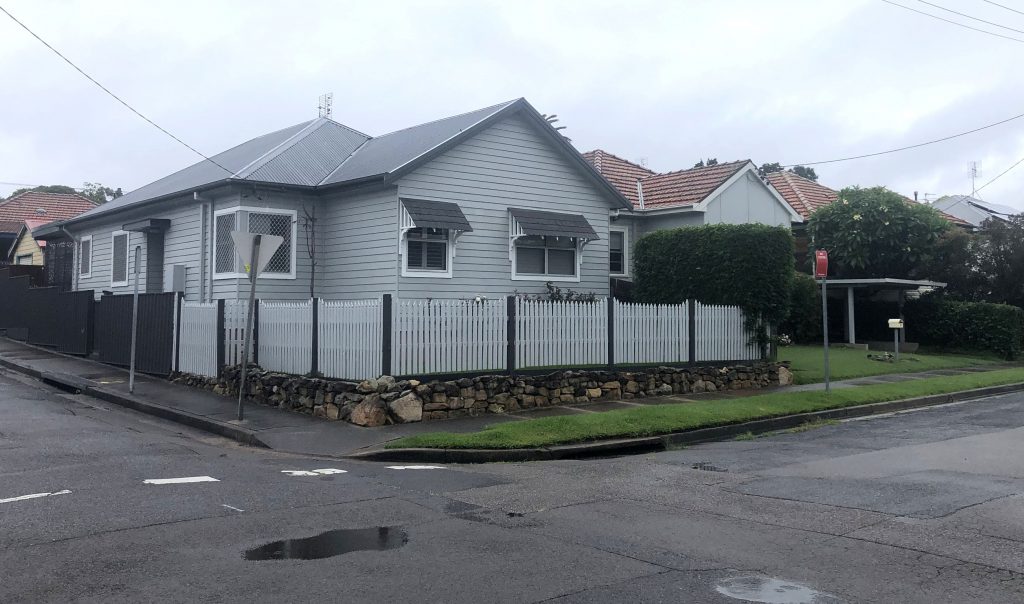
Licensees
- Robert Cairns (1864 to 1879)
- Joseph Garrett/Garratt (1880 to July 1883)
- Andrew Wilson (July 1883 to 1884)
- Henry Frost (1885 to 1887)
- J Tennyson (1887? to 1888)
- John Sample (1888 to July 1889)
- Dorothy Cairns (July 1889 to 1892)
- J R Lackey/Leckey (1893)
- Thomas Weaver (1893 to 1901)
- William George King (1902 to 1910)
- James J Hayes (August 1911 to December 1911)
- John Sample (1912 to 1913)
- Edwin Cox (1914 to May 1919)
- George Hudson (May 1919 to December 1920)
- Maurice Sussman (December 1920 to January 1921)
Gold Miners’ Arms Hotel (1865-1921)
More information can be found in my article on Stoker’s Hotel.
The hotel was located on the north east corner of Elder and Grainger Streets and had a number of names in its history. From 1865 to 1915 it was variously known as …
- Gold Miners’ Arms
- Gold Miners’ Home
- Gold Diggers’ Arms
- Gold Miners’ Home Hotel
- Miners’ Home Hotel
- Gold Miners’ Hotel
Trying to put dates to these names has proved to quite tricky as it seems the names were used interchangeably and inconsistently. Sometimes the hotel name as it appears in the Government Gazette doesn’t match what appears in newspaper articles. It’s possible that the proliferation of names was a contributing factor to the hotel often being simply referred to as “Stoker’s Hotel”, even long after the first licensee John Stoker ceased to run the hotel in 1885.
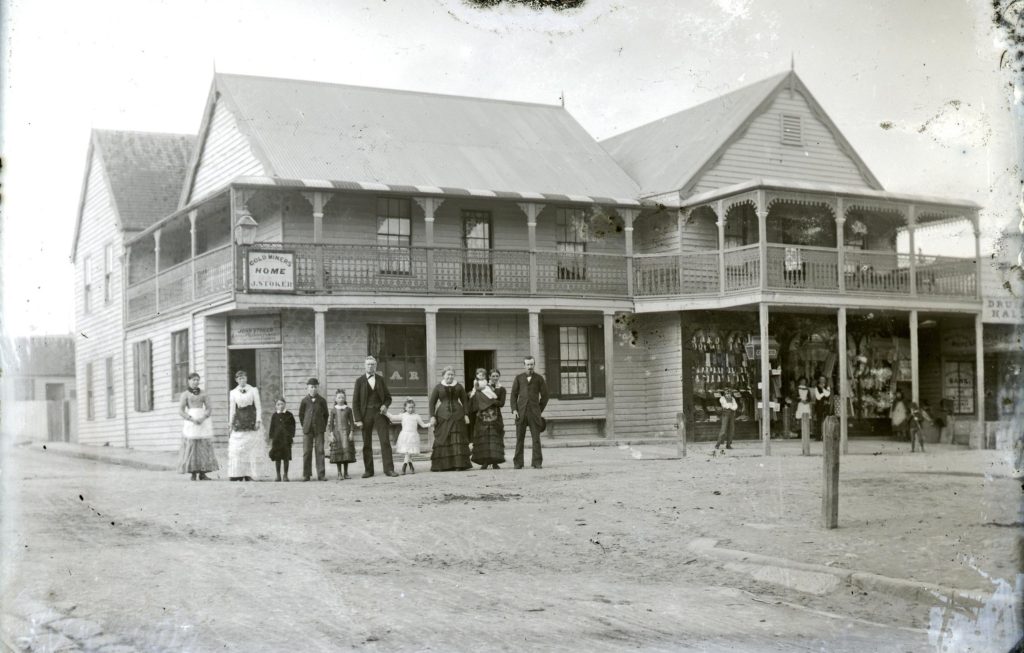
In 1915 the name was changed to the “Central Hotel”.

John Stoker purchased Lot 1 of Section E of Lambton township in September 1865 (Vol-Fol 19-190), and was granted a publican’s license in November 1865.
In 1921 the hotel, at that time operating as the Central Hotel, was closed when its licence was revoked by the Licenses Reduction Board. The hotel building was demolished in 1926.
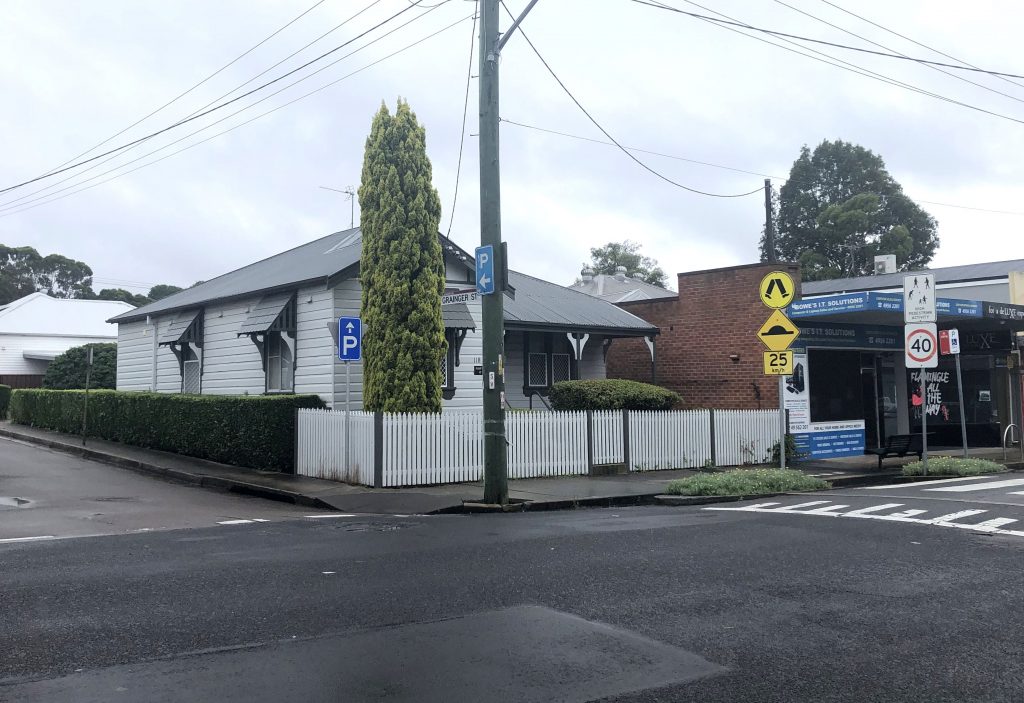
Licensees
- John Stoker (1865 to November 1885)
- William Ralph (November 1885 to 1889)
- Mary Ann Ralph (1890 to 1891?)
- William Baker (1891 to 1894)
- Edward J Stoker (1895 to 1897?)
- James Jamieson (1898 to 1899)
- Cornelius O’Hea (1899 to 1902)
- Arthur S Eastmuir (1903)
- John Edward Ring (1903 to July 1905)
- William A McMichael (July 1905 to July 1907)
- William Wood (July 1907 to 1912?)
- Charles Nelson (1913? to July 1914)
- George Malbon (July 1914 to 1921)
Northumberland Hotel (1866-present)
The Northumberland Hotel is located on the south west corner of Elder and Morehead Streets. It is the oldest of the hotels that is still operating, and has retained the same name since it opened in 1866.
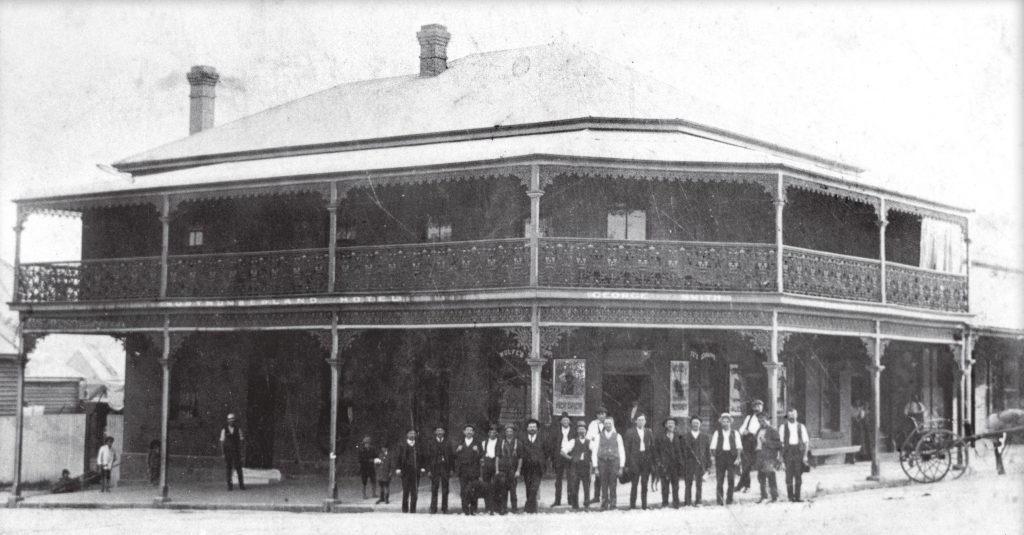
John Dent purchased Lot 10 of Section H in Lambton township in November 1865 (Vol-Fol 25-26), and opened the Northumberland Hotel in July 1866.
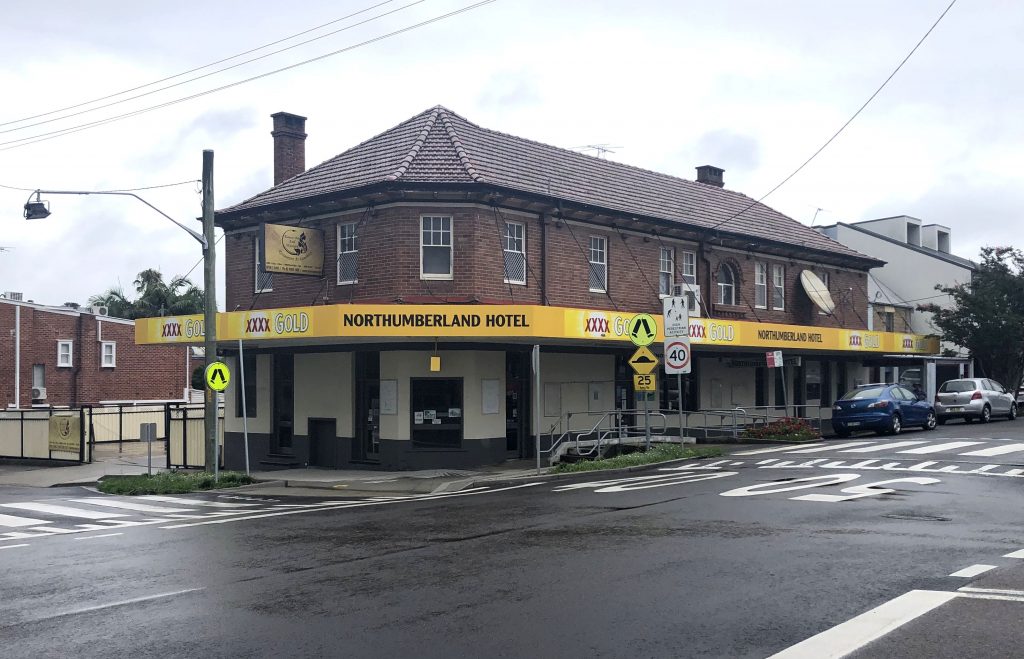
See also
- Northumberland Hotel page at ANU Open Research Library, which contains some photographs of the hotel from the 1920s to 1970s.
Licensees
- John Dent (1866 to September 1873)
- Michael Avery (October 1873 to March 1877)
- George Bunn (March 1877 to 1884)
- Joseph Tranter (1885 to 1890)
- Eli Chadwick (1890 to 1898)
- William Griffiths (1899 to August 1907)
- Andrew Dougal Watson (August 1907 to July 1912)
- Thomas Brown (July 1912 to February 1913)
- George Smith (February 1913 to 1921)
- George Cowan (1921 to 1921)
- Bert Nordsvan/Nordvan (1922)
- A Ward (August 1922 to February 1923)
- Albert Louis Jordan (February 1923 to 1923)
- Victor G Elsely (1923 to March 1924)
- Frederick Stephen Rouhan/Ranhan (March 1924 to November 1924)
- Edward Percy Dixon (November 1924 to October 1925)
- Richard Francis Hamilton (October 1925 to May 1941)
- Hilder Hamilton (May 1941 to August 1941)
- Leslie Philip Higgs (August 1941 to December 1941)
- Duncan Forbes McGeachie (December 1941 to December 1942)
- William James Green (December 1942 to July 1943)
- John Andrew Joseph George Eason (July 1943 to July 1944)
- William Henry Cowcher (July 1944 to June 1946)
- Percival Ludington (June 1946 to October 1952)
- Reginald Darell Honey (October 1952 to March 1956)
- John Percival Arthur Smith (March 1956 to July 1958)
- Henry Morton Lumby (July 1958 to May 1963, died)
- David Alfred James Blanch (May 1963 to March 1965)
- John Alderson and Jeanette Marie Gay (March 1965 to October 1965)
- Charles John Wilson and Margaret Josephine Wilson (October 1965 to February 1968)
- Archibald Anthony McLusky (February 1968 to February 1970)
- William Raymond Burnage (February 1970 to February 1971)
- Percy Raymond York (February 1971 to March 1972)
- Ronald Padgett (March 1972 to June 1976)
- Warren Ewart Cake (June 1976 to July 1977)
- Robert William Rusden and Barbara Lee Rusden (July 1977 to January 1979)
- Janice Marlene Perrington and George Alexander Perrington (January 1979 to ????)
- ?
Rose, Thistle and Shamrock Inn (1868-1896)
Located on the south east corner of Elder and Grainger Streets. Also known as
- Rose and Shamrock Inn
- Rose, Shamrock and Thistle Hotel
- Federal Hotel (July 1895 to 1896)
Michael Doyle purchased Lot 1 of Section H in Lambton township in August 1867. (Transfer noted on Vol-Fol 36-203, Title Certificate on Vol-Fol 54-38)

Michael Doyle was granted a publican’s in March 1868 for the “Rose and Shamrock Inn”. In June 1868 he began advertising his hotel as “The Rose, Thistle, & Shamrock Inn.”

From July 1882, Guiseppe Turri owned the hotel land and building while a variety of licensees operated the hotel. In July 1895 Turri became the licensee and changed the name to the “Federal Hotel”. In April 1896 a fire at the hotel caused considerable damage. The fire must have placed Guiseppe Turri in dire financial straits, for in August 1896 he was forced to sell off a “large quantity of household furniture”, and the hotel never re-opened.

Licensees
- Michael Doyle (1868 to 1870)
- Alexander Smith (1871 to July 1873)
- Thomas James (July 1873 to May 1874)
- John Beveridge (May 1874 to June 1875)
- James Parker (July 1875 to July 1877)
- John Wills (August 1877 to October 1877)
- Michael Doyle (October 1877 to July 1878)
- Mary Doyle (July 1878 to May 1879)
- Martin Durham (May 1879 to 1880)
- Henry/James Sheedy (1881 to March 1883)
- Michael Lorraine (March 1883 to 1886)
- John Champion (February 1887 to November 1887)
- William Griffiths (November 1887 to March 1891)
- Thomas Vipon (March 1891 to August 1892)
- John Ward (August 1892 to 1893)
- William Kelly (1894 to July 1895)
- Guiseppe Turri (July 1895 to April 1896)
Rose and Crown Inn (1869-1871)
Located at 103 Elder St. John Platt purchased Lot 5 of Section H in Lambton township in October 1866 (Vol-Fol 39-245), and erected a building on the land. In 1869 George Lonsdale took a three year lease on the building and applied for a publican’s license. At the license hearing in April 1869 the building was described as follows …
“A portion of the house is two-storey, built of stone and brick ; the wooden portion contain four rooms, two on the ground floor and two upstairs. The brick building is attached to a four room cottage, which house contains two front rooms of moderate size, and two small back rooms, one used as a kitchen.”
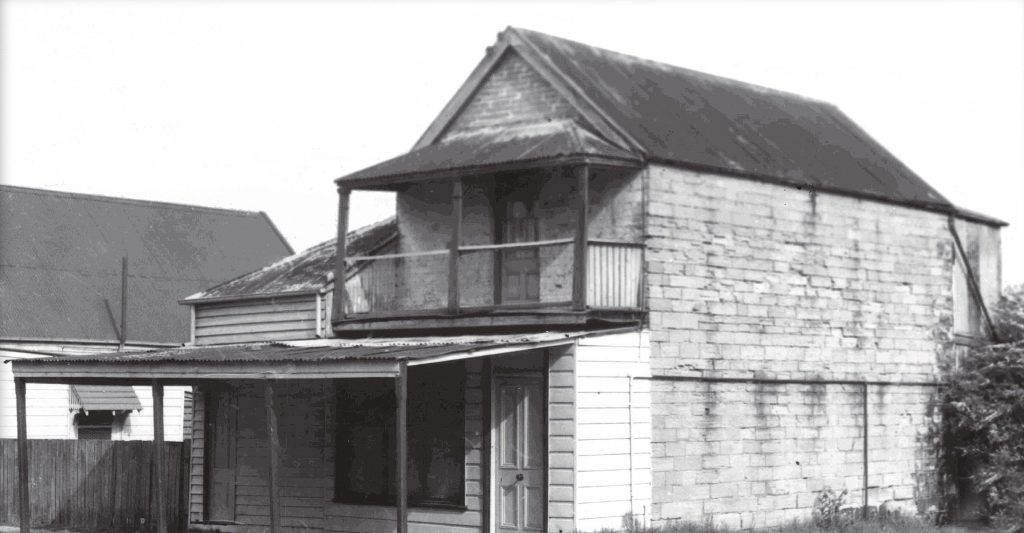
Despite police objections, a publican’s license was granted to George Lonsdale, however his tenure was short lived. By 1870 John Platt had become licensee as well as owner of the hotel. In June 1871 Platt sold the land and building to James Horton/Haughton (Vol-Fol 122-233). After the sale Platt continued as licensee, but Haughton immediately advertised the hotel as being available to let.
William B Richardson was granted the license in August 1871, but whether he ever operated the hotel is unclear, as there are no further mentions of the hotel in the papers and the “Rose and Crown” is absent from the 1872 gazetted list of publican licenses.
Licensees
Prince of Wales (1870-1908)
Located on the south west corner of Dickson and Morehead Streets.

John Martin Sawyer purchased Lot 10 of Section D of Lambton township in November 1868. (Vol-Fol 78-28). In January 1870, David Jenkyn obtained a publicans’ licence and opened the Prince of Wales Hotel. (Note in the advertisement below that the location is described as being “on the main road from Newcastle to Wallsend, as Dickson St was originally planned to be the main road.)

Lot 10 was subdivided into two halves in 1874, and in 1889 John Sheedy purchased the northern half where the hotel was situated. Sheedy subsequently became the licensee of the hotel in 1895. After he ceased to be licensee, he sold the property to Tooth and Co in 1900, but purchased the property back again nine years later in January 1909.
At the Licensing Court hearing in August 1909, “Inspector Goulder reported that the license of the Prince of Wales Hotel, Lambton, had not been renewed, and that the premises were closed on August 18.”and after the hotel was delicensed in 1909, Sheedy purchased the property back from Tooth and Co.
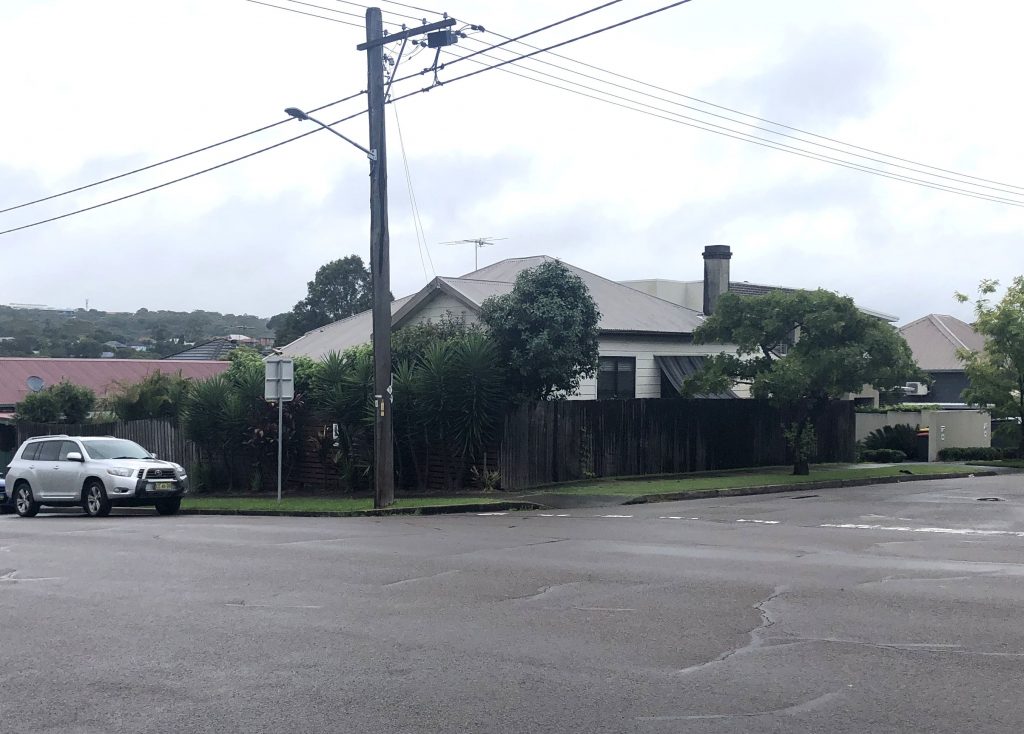
Licensees
- David Jenkyn/Jenkins (1870 to July 1883)
- John Mawkes (July 1883 to 1884)
- John West (1885)
- Edward Thorley (1886 to April 1889)
- Squire Smith (April 1889 to April 1890)
- Catherine E Smith (April 1890 to 1894)
- John Sheedy (1895 to February 1900)
- Charles A Howard (1900 to November 1901)
- William C St Leger Gordon (November 1901 to August 1909)
Red Lion Inn (1871-1896)
The hotel was located on the north west corner of Morehead Street and Young Street (now Newcastle Road). The hotel building still stands today, and is a private residence.
In February 1871 William Densley purchased Lot 1 in the new subdivision of Grovetown (DP54), just to the north of the Lambton township. (Vol-Fol 116-154). It seems he acted quickly in erecting a hotel building for within a few months in May 1871 the licensing court “granted permission to Dinah Williams to remove her license from the Red Lion Hotel, Waratah, to a new house to be known by the same sign at Lambton.” By September 1871 the hotel was operational, with a committee meeting of residents of the Commonage being held on the premises.
In January 1872, Dinah Williams was advertising “To Let, The Red Lion Hotel, Old Lambton, now doing a steady business.” By the beginning of 1872 Uriah Broom, the newly elected Mayor of the newly formed Lambton Municipal Council was the licensee of the Red Lion Inn.
In June 1896 at the Wallsend Licensing Court, the license for the Red Lion Inn was withdrawn.
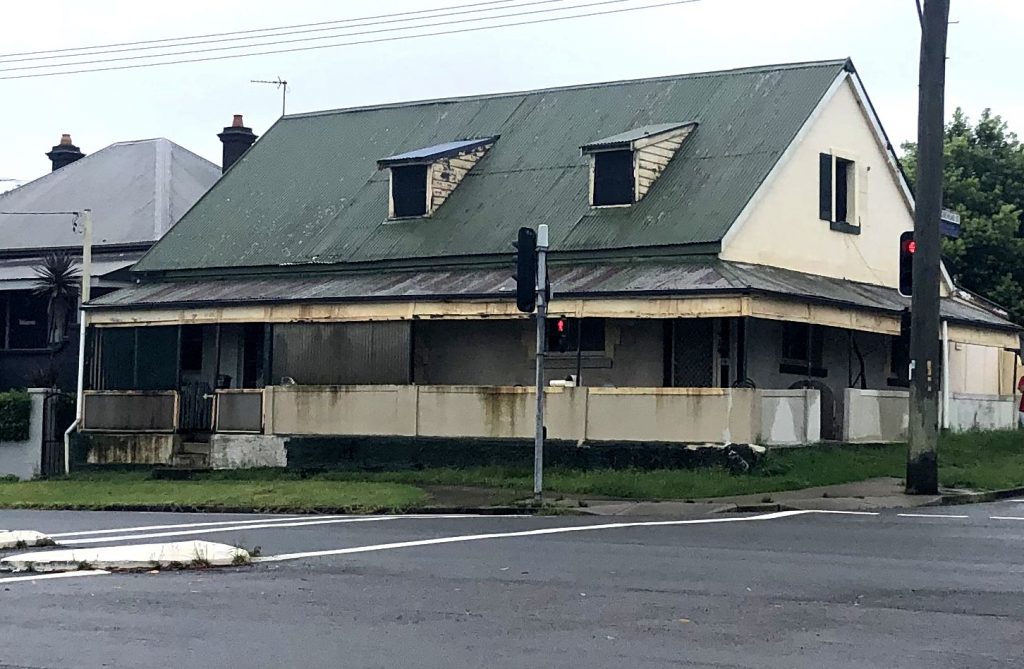
Licensees
- Dinah Williams (1871 to January 1872)
- Uriah Broom (February 1872 to June 1874)
- William Densley (1874 to September 1878)
- Joseph Lidbury (October 1878 to August 1879 (died))
- Thomas James (January 1880 to June 1881)
- James James (June 1881 to January 1893 (died))
- Harriett James (January 1893 to 1894)
- Henry Grant (1895 to June 1896)
Lancashire Arms Hotel (1874-1881)
The hotel was located on the south east corner of Pearson and Grainger Streets. The hotel opened as the “Lancashire Arms” in 1874, and changed to the “Welcome Home Hotel” in December 1875. It was also sometimes referred to as the “Welcome Home Inn”.

Peter and Thomas Young purchased Lot 1 of Section L in Lambton township in September 1865. (Vol-Fol 19-22 and 19-23) and retained ownership of the land and buildings for the life of the hotel.
In May 1880 the current licensee, Samuel Dawson, was charged with “committing a breach of the Publicans’ Act by abandoning his licensed house, the Welcome Home Hotel, Lambton, between the 17th and 30th April.” He was found guilty and his publican’s license was voided. The owner of the hotel, Peter Young applied at that time to have the license transferred to himself. The request was initially denied, but granted the following month in June 1880. Whether Peter Young opened the hotel for business or for how long, is uncertain. There is no further mention of the Welcome Home Hotel after the notification of the granting of the license in June 1880, and the hotel does not appear in the list of publican’s licenses in 1881.
In June 1889 the property and building was advertised for sale, promoted as …
That splendid Corner Block of Land, reaching from Howe-street along Grainger street to Pearson-street, Lambton, upon which is erected an Eight-roomed W.B. House, with Kitchen, large Yard, Stable,Washhouse, formerly known as the Welcome Home Hotel.
Newcastle Morning Herald and Miners’ Advocate, 18 June 1889.
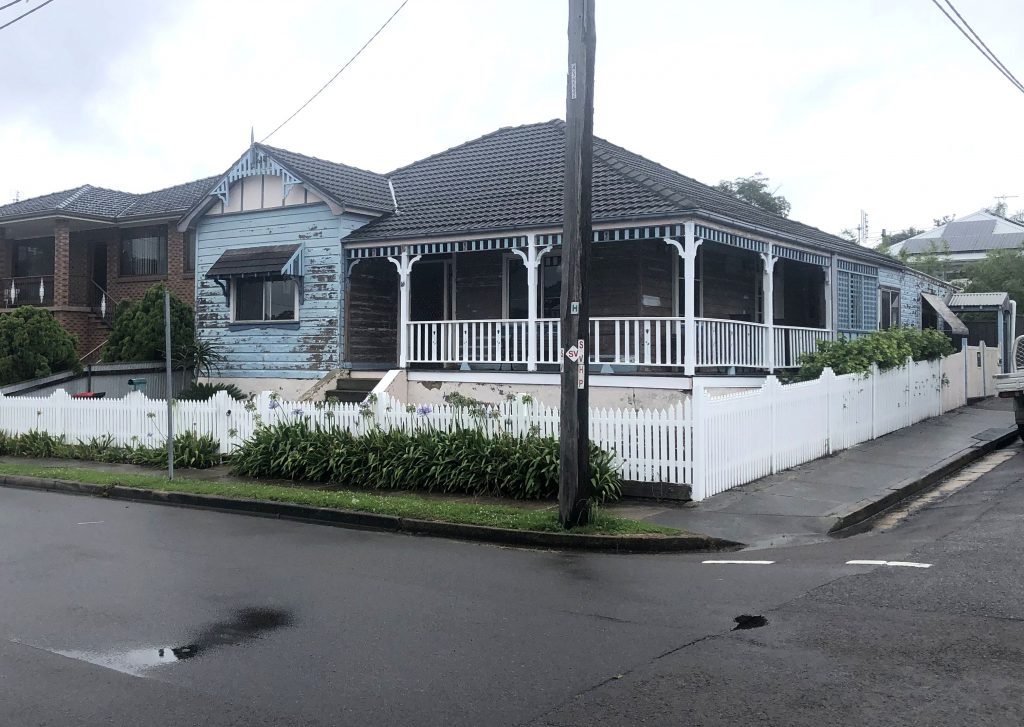
Licensees
- Christopher Halpin (April 1874 to December 1875)
- John Gordon (December 1875 to June 1879)
- Samuel Dawson (June 1879 to April 1880)
- Peter Young (June 1880 to 1881?)
Marquis of Lorne Hotel (1874 to present)
[See also my July 2024 article for The Local, published 150 years after the the opening of the Marquis of Lorne Hotel.]
Located on the north west corner of Morehead and Dickson Streets. The hotel was sometimes spelled as “Marquis of Lorn” or shortened to “Marquis O’Lorne”. In 2008, after a major renovation, the name changed to “The Mark Hotel” .
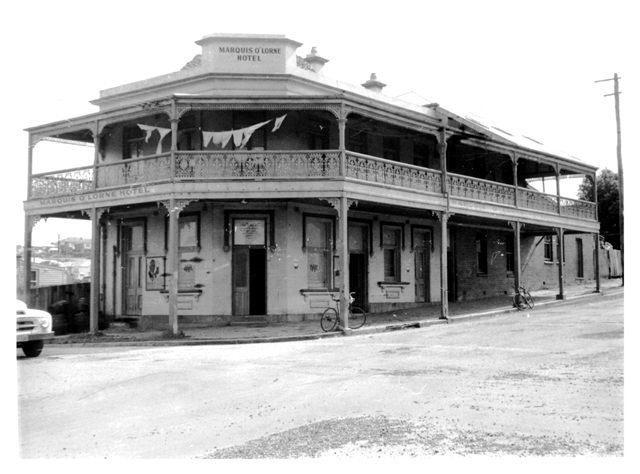
Alexander Smith had been the licensee of the Rose, Shamrock and Thistle Hotel in Elder Street until July 1873. In October 1873 he purchased the east half of Lot 10 of Section A in Lambton township. (Vol-Fol 177-187), and immediately made plans to erect a hotel. Construction was underway in January 1874, and the hotel opened on 20 June 1874.
The hotel was sold in June 1876 to Joseph Thomas Morris who also became the licensee. In August 1876 to hotel was sold to John and Joseph Woods (wine and spirit merchants of Newcastle) and Richard Ward became licensee.
In November 1880, Richard Ward applied to move the license of the Marquis of Lorne hotel to premises in Elder Street, however the Wood brother (owners of the hotel) objected and the licensing court refused the application. The following month in December 1880, the license of the Marquis of Lorne Hotel was transferred to Benjamin Tonks, and Richard Ward was granted a license for the (first) Commercial Hotel in Elder Street.
In 1929 another attempt was made to move the location of the Marquis of Lorne Hotel. In September 1929, the new licensee John Thomas Quinlivan applied to move the license of the hotel “to premises to be erected on Part of Lot 2, Section A, having a frontage of 112.5 links (22.6m) to Robert Street Jesmond.”

At the licensing board hearing on 25 September 1929, the application for transfer was opposed by many. After hearing arguments and inspecting the proposed site, on 26 September 1929 the board refused the application for the license transfer “on the ground that the reasonable requirements of the district did not justify the removal.” Quinlivan stayed on as licenseee of the Marquis of Lorne Hotel in Lambton for another year, when the license was transferred to John Baptist Beisler in November 1930.
In 1960, the original hotel building was demolished and a new building erected by Tooth and Co at a cost of £67,508 on an adjoining block of land. The site of the original hotel building is now the hotel’s car-park alongside Morehead St.
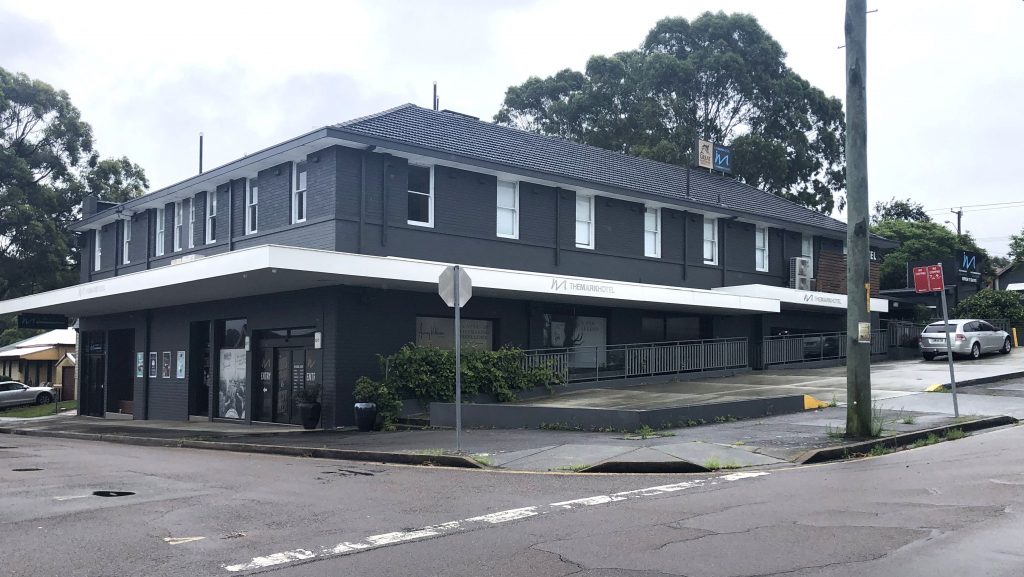
See also:
- Marquis of Lorne Hotel page at ANU Open Research Library, which contains some photographs of the hotel from the 1920s to 1960s.
Licensees
- Alexander Smith (June 1874 to May 1876)
- Joseph Thomas Morris (June 1876 to September 1878)
- Richard Ward (September 1878 to December 1880)
- Benjamin Tonks (December 1880 to February 1883)
- James Lunn (February 1883 to May 1884)
- Noah Davis (May 1884 to 1886)
- Alexander Sneddon (1887 to March 1883)
- John Williams (July 1888 to August 1889)
- Thomas Pryde (August 1889 to December 1897)
- John Donnelly (December 1897 to 1903)
- John Thomas (1904 to October 1907 – cancelled)
- Matthew Ernest McFarlane (October 1907 to 1910)
- James J Fitzpatrick (November 1910 to February 1914)
- Mathew Wilson (1914 to December 1915)
- Robert Lionel Robinson (December 1915 to August 1923)
- John Thomas Kay (August 1923 to July 1926)
- Robert Jackson (1927 to July 1928)
- John R Healey (July 1928 to November 1928)
- John Thomas Quinlivan/Quinlevan (November 1928 to November 1930)
- John Baptist Beisler (November 1930 to April 1936)
- Ada Annie Beisler (April 1936 to May 1941)
- Peter William Beisler (May 1941 to April 1948)
- Henry Pitz Beisler (April 1948 to ????)
- ?
Land title certificate Vol-Fol 7592-41 shows that the hotel property was leased to Henry Pitz Beisler until February 1979, ending an impressively long stint of 49 years involvement by the Beisler family!

Pine Apple Hotel (1874-1881)
The hotel was sometimes spelled as “Pineapple”, and in the Government Gazette lists of publican licenses it is recorded as “Pine Apple Inn”. It was also referred to as “Bunn’s Hotel”.
Old newspapers report the hotel as being in North Lambton, or in Dark Creek, which is the original name of Jesmond. To confuse things further, some of the Government Gazette lists note the hotel as being in “Duck Creek”, a phonetically erroneous reference to “Dark Creek”. There are no known photographs of the hotel.
Although there is some uncertainty about the exact location, I believe the hotel was situated on one of the original allotments outlined below, which today corresponds to 300-304 Newcastle Road. (See the following section for the reasoning.)
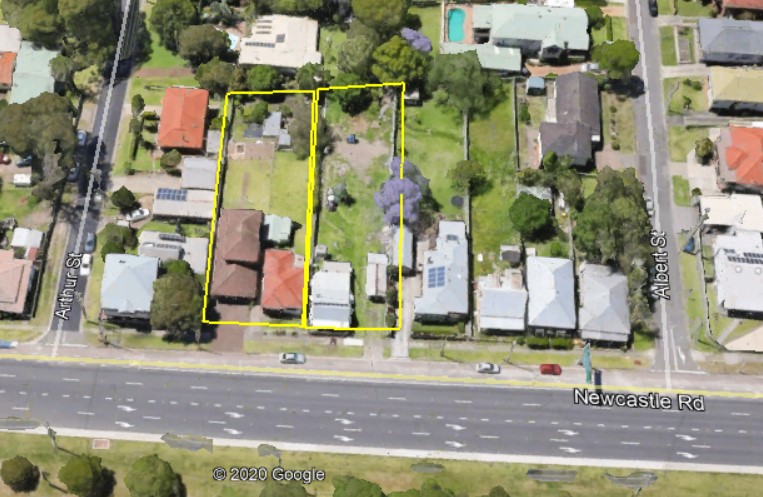
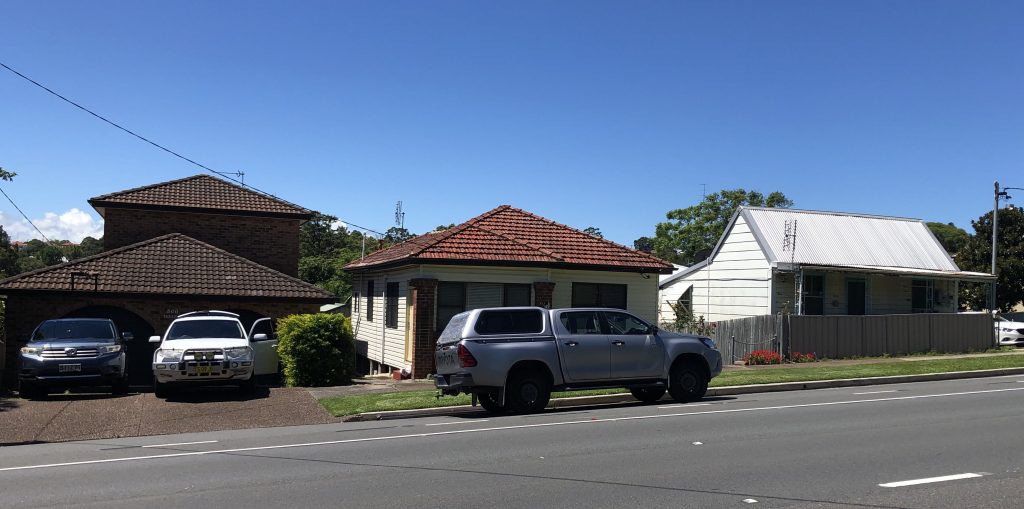
The time that the hotel ceased trading is not known with certainty. After Charles Bunn, the last licensee, was granted the license in April 1881, mentions of the Pine Apple Hotel in the newspaper disappear. Charles Bunn entered into insolvency in June 1881, just two months after being granted the license. Presumably this marked the end of the Pine Apple Hotel.
The probable location
Almost all the contemporaneous newspaper reports (1874-1881) of the hotel state that the hotel was in “North Lambton”, which in this period refers to a very specific square block of 50 acres granted to Daniel Jones. Some reports refer to the hotel being in Dark Creek, which referred to the overall locality. (Note that the watercourse named Dark Creek flows diagonally through the “North Lambton” land grant.)
A number of articles state that the hotel was on the main road, or Hartley St, which places the hotel somewhere between Henry Street and George Street.
The first licensee of the hotel in 1874 was Thomas Bunn and the last licensee in 1881 was his son Charles, which suggests that Thomas may have been the owner of the hotel. This is corroborated by a May 1879 advertisement … “TO LET, the PINE APPLE HOTEL North Lambton. Apply to Thomas Bunn.”
Searching the Land Titles at the Historical Land Records Viewer site, reveals that in September 1873, Thomas and his wife Elizabeth purchased Lot 13 (See Vol-Fol 169-220) and Lot 14 (see Vol-Fol 169-219) of Section D of North Lambton. The timing of these purchases fits with the opening of a hotel the following year.
The final clue is from the Miners’ Advocate and Northumberland Recorder of 11 August 1875 where Edwin Griffiths advertised the commencement of his business as an undertaker “in North Lambton, near Bunn’s Hotel.”
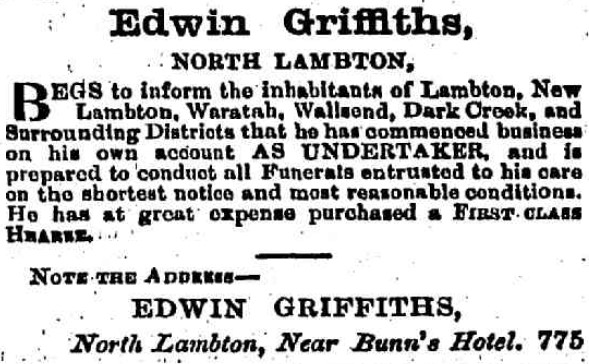
The Historical Land Records Viewer in Vol-Fol 236-94 shows that Edwin Griffiths purchased Lot 15 of Section D of North Lambton, adjacent to the Bunn’s two allotments. As the Deposited Plan of the subdivision of Section D is not available online, I have created an overall map showing the lots between Arthur and Albert Streets by splicing together the lot boundary maps from each individual Title Certificate.
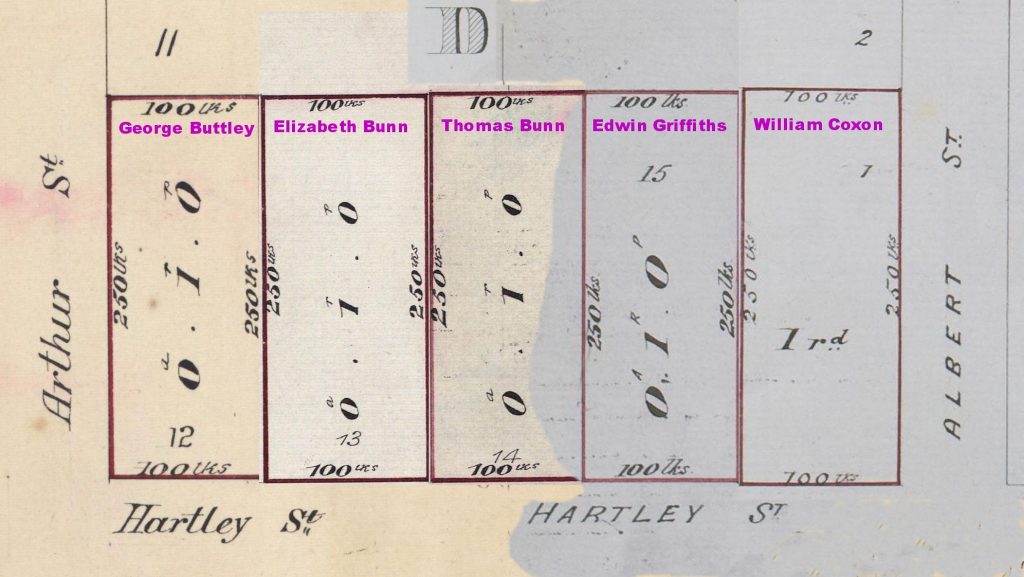
The improbable location
A September 1929 newspaper article states that “Bunn’s Hotel was situated in Hartley-street, at the intersection of Steel and Robert Streets.” The article is reporting the reminiscences of local residents nearly 50 years after the Pine Apple Hotel closed. I am almost certain that they were confusing the Pine Apple Hotel with the Coal Miners’ Home Hotel, which was located at that intersection during the same period that the Pine Apple Hotel was operating.
There is no other evidence I could find, in newspaper reports or government gazettes or land sale information, either before or afterwards that corroborates the 1929 suggestion that the Pine Apple Hotel was in Steel/Robert Street.
Licensees
- Thomas Bunn (1874 to 1877)
- Henry Simpson (July 1877 to ????)
- Samuel Dawson (1878 to June 1879)
- Patrick Kelly (June 1879 to July 1879)
- Henry Forrester (July 1879 to March 1881)
- George Shoesmith (March 1881 to April 1881)
- Charles Bunn (April 1881 to June 1881)
Jesmond Hotel (1875-1911)
The hotel was located at 52 Robert St Jesmond. Because Richard, Isabella and John Sneddon were licensees for over 20 years, it was also known as “Sneddon’s Hotel”.
William Hellier purchased a block of land between Robert and Michael Streets in Jesmond in March 1875. (Vol-Fol 206-27) In August 1875 he was granted a publican’s license for “The Jesmond Hotel”.
In July 1887, Hellier sold the property to Richard Sneddon who also became licensee of the hotel. In Februray 1900, Sneddon sold the hotel to Castlemaine Brewery and Wood Brothers, but remained as licensee.
The growing influence of the temperance movement led to the “Local Option Vote” in NSW in September 1907, a referendum where people could vote whether to continue, reduce, or eliminate licensed premises in their electorate.
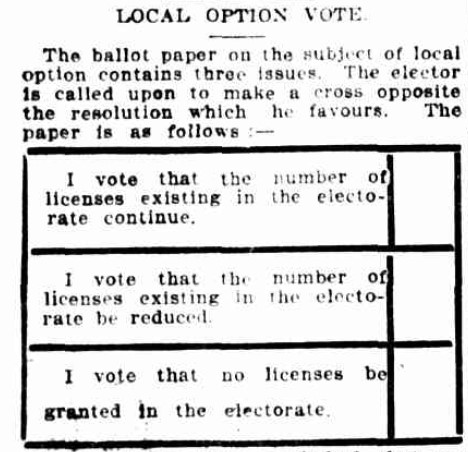
When the result had been tallied, of the 90 electorates in NSW, 25 voted for a continuance of licenses, while 65 voted for a reduction in licenses, including Kahibah electorate which contained Lambton township. A special licensing court in July 1908 decided to reduce the number of hotels in the Kahibah electorate by 7, some to be closed immediately, and some given a few years notice. The Jesmond Hotel was one of the hotels selected for closure, and given three years notice.
One interesting side notes, is that some months prior to this decision, in May 1908 an advertisement had appeared in the paper, calling for tenders for the rebuilding of the hotel in brick. This may have been a pre-emptive move by the hotel owners to ward off possible closure by demonstrating the go-ahead nature of their enterprise. Needless to say, with the licensing board’s decision to close the hotel in three years time, the brick re-build never eventuated.
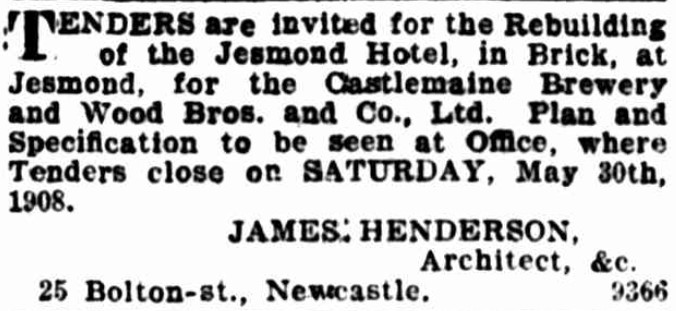
The Jesmond Hotel continued to trade until July 1911. Two years later in July 1913 the hotel land and buildings were put up for sale and purchased by James Stevenson, a miner from Jesmond.
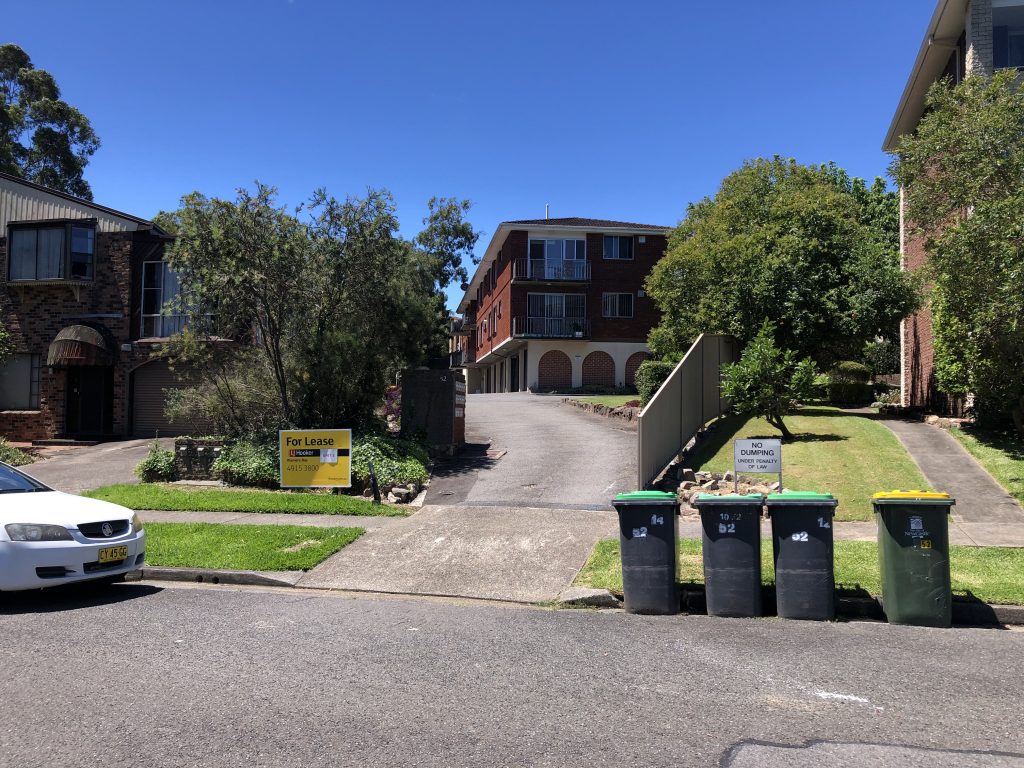
Licensees
- William Hellier/Heiller/Hilliar (1875 to 1879)
- William Fenwick (1880 to 1883)
- Edmond Tiplady (1884 to July 1887)
- Richard Sneddon (July 1887 to February 1902)
- Isabella Sneddon (March 1902 to 1903)
- John Robertson Sneddon (1904 to 1911)
Royal Hotel (1875-1882)
The Royal Hotel was situated on the north west corner of Elder and Grainger Streets. Joseph Hunter purchased Lot 14 of Section F in Lambton township in November 1865. (Vol-Fol 25-7) Ten years later in July 1875, Hunter was granted a publican’s license and opened a hotel on the site. After Joseph Hunter died in May 1880, his widow Ann ran the hotel for a year until Martin Durham became licensee in 1881. The hotel seems to have lasted not very long after this, with the last mention in the papers being a brief reference to “Durham’s Hotel” in June 1882.
There are no known photographs of this hotel
Licensees
- Joseph Hunter (July 1875 to May 1880, died)
- Annie Hunter to (June 1880 to July 1881)
- Martin Durham (July 1881 to 1882)
Coal Miners’ Home Hotel (1876-1879)
Also known as the “Coal Miners’ Arms”, there is very scant information and no photographs available for this short-lived and unsuccessful hotel.
Lewis Haines, a miner from Lambton, purchased Lot 1 of Section B on the corner of Robert St in the township of Jesmond in December 1873. In June 1876 he was granted a publican’s license for “The Coal Miners’ Home Hotel” in Jesmond.
Within a few months, in September 1876 Haines was advertising the hotel for sale or to let.

A sale did not eventuate at this time, the land records showing that Haines retained ownership of the land until 1883. There was another attempt to sell in June 1877, the agent describing the hotel and property as …
…. being nearly a new house,and doing a large business. This stands upon one acre of fine cultivating land; has six chains frontage to the main road, with kitchen, stable, outhouses, and a splendid orchard. This is the most compact place, on the main road to Wallsend.
The “six chains” (=120 metres) frontage to the main road matches the dimensions of Lewis Haines block, with 60 metres frontage on each side of the corner block. No sale occurred, with the agent withdrawing the property from sale “as there was no bid covering the reserve price.”
Sometime before October 1878, it appears that the licensee was Robert McBain (or possibly McBlain) who advertised the hotel and attached orchard for let. The last licensee was Young Bedford, who for reasons unknown abandoned the hotel in March 1879, resulting in the cancellation of the license. The hotel never re-opened. The following month in April 1879 the property was put up for auction, but like the previous two attempts, no sale eventuated.

Licensees
- Lewis Haines/Haynes (June 1876 to ????)
- Robert McBlain/McBain (1878)
- Young Bedford (???? to March 1879)
Miners’ Arms Hotel (1877-1910)
Henry Johnson, a miner from Lambton, purchased Lot 8 of Section L of Lambton township in March 1873. (Vol-Fol 164-25)

By July 1874 Johnson was operating a boarding house on the site. In January 1877 the Newcastle Morning Herald and Miners’ Advocate reported that …
Mr. James Bradley has opened the premises lately occupied by Mr. Johnson as a boarding house, in Howe-street, as an hotel, under the sign of the Miners’ Arms. Mr. Bradley has been employed at the Lambton Colliery for many years, and is held in the greatest respect by his fellow workman, and for that reason alone, no doubt, will receive to [sic] share of support.
Newcastle Morning Herald and Miners’ Advocate, 15 January 1877.
By August 1878 Thomas Stokes had become the licensee, and ran the Miners’ Arms in Henry Johnson’s premises for the next three years. This situation with Stokes as licensee and Johnson as owner was one that suited neither of them, and each had their own plans to be both owner and licensee of a hotel on Howe Street!
In January 1876 Henry Johnson had purchased Lot 10 of Section L, on the corner of Howe and Morehead Streets, and in January 1880 Thomas Stokes purchased Lot 9, the block of land between Johnson’s two properties. On 15 February 1881 at the Lambton Police Court, Stokes “applied for a transfer of his license for the Miners’ Arms Hotel, Howe-street, to another house in the same street.” Johnson’s legal representative Mr Dart objected to the application …
“… on the grounds that the applicant [Stokes] taking the license from the [Johnson’s] house and closing it would reduce the capital value of the same, and also that the house to which he [Stokes] applied to have the license transferred was not fitted for a licensed house.”
Stokes’ legal representative Mr G Wallace countered the objection by pointing out …
“… that his client had, as the lease had expired, a perfect right to transfer the license to another house. Mr. Johnson was about to apply for a license for a new house in Howe-street, and had it in his power to eject Mr, Stokes at any time if he wished, and in the event of his doing so Mr. Stokes had no redress.”
It is a little difficult to ascertain the exact motivations here, but it seems that with Henry Johnson about to set himself up as both owner and licensee of a hotel, he was keen to prevent Stokes doing the same. Johnson had a win on this occasion, for after inspecting the Stokes’ premises the Bench “refused the application on the ground that the house was too small to be licensed.”
Henry Johnson then proceeded with his plan of setting himself up as a licensed publican in his premises on Lot 10 (corner of Morehead and Howe Streets). On 8 March 1881 at Lambton Police Court …
“A license was granted to Henry Johnson for a house in Morehead-street, Lambton, to be known by the sign of the Exchange Hotel.”
Not to be outdone, the very next week on 18 March 1881 Thomas Stokes again made application to transfer the Miners’ Arms license to his own premises. Again, Henry Johnson objected, but this time in vain, his objection …
“… was ruled informal as he had not given the applicant the usual seven day’s notice of his intention to object.”
Stokes’ application was granted, and he moved the Miners’ Arms from Johnson’s house on Lot 8 into his own property on Lot 9, right next door to Johnson’s new Exchange Hotel on Lot 10!


In July 1908, the Local Option Court for the Kahibah electorate handed down their decision on seven hotels to be closed. The Miners’ Arms Hotel at Lambton (Thomas O’Malley, licensee) was given three years notification to close. With no long term future for the hotel, O’Malley almost immediately had his license transferred to William Harney. The hotel only traded for another two years, at the Newcastle Licensing Court in July 1910 …
Inspector Goulder reported that the license of the Miners’ Arms Hotel, Lambton, had not been renewed, the premises having closed on June 30th.
Newcastle Morning Herald and Miners’ Advocate, 8 July 1910.
Licensees
- James Bradley (January 1877 to ????)
- Thomas Stokes (1878 to April 1889)
- Mark Wood/Woods (May 1889 to 1891)
- Thomas Stokes (1892 to 1899)
- George E Mansfield (June 1900 to April 1901)
- Samuel Dunstan (April 1901 to August 1901)
- Edwin Maddison (September 1901 to 1904)
- Thomas Weaver (1905 to 1906)
- James Lyons (1907 to ????)
- Thomas O’Malley (???? to August 1908)
- William Harney (August 1908 to June 1910)
Royal Oak Hotel (1878-1881)
This very short lived hotel was located somewhere in Dickson St, with John Edwards being the one and only licensee. Edwards’ wife Hannah purchased a block of land in Dickson St in 1872, and it is possible the hotel was located on this site, which is now 59 Dickson St. There are no known photographs of the hotel.
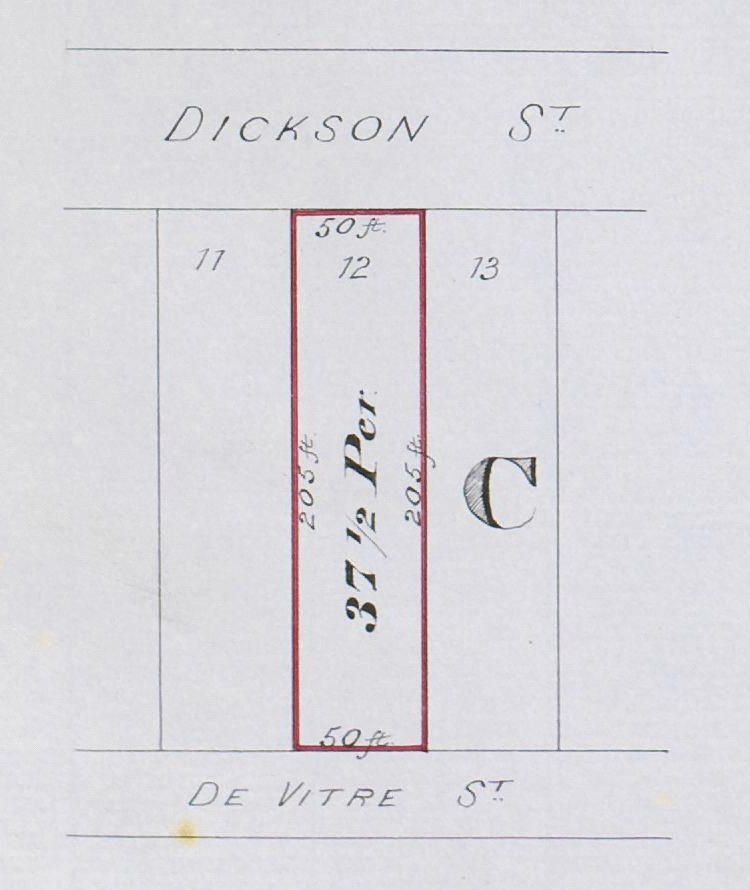
In January 1881 John Edwards advertised a six-roomed dwelling house to let, with instructions to apply at the Royal Oak Hotel. After the license renewal listed in the Government Gazette in September 1881, there are no further mentions of the hotel.
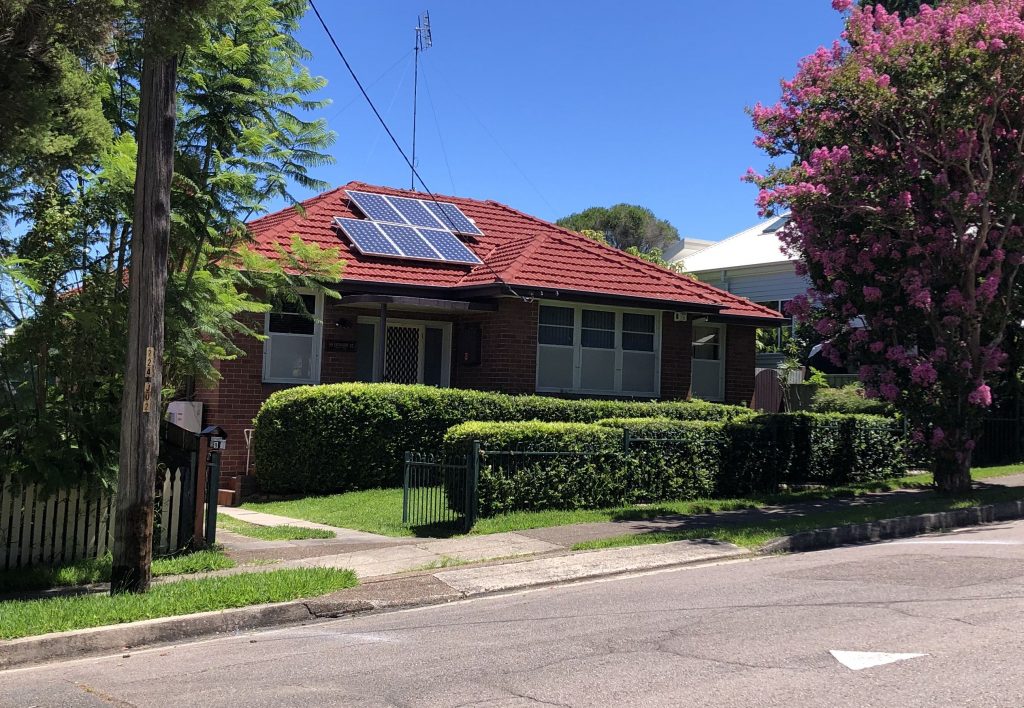
Licensees
Race Horse Inn (1878-1882)
Opened in Elder St in July 1878 as the Race Horse Inn, in premises owned by William Reay, and Henry Doherty as the first licensee. The name changed to Reay’s Hotel in June 1881 when William Reay acquired the hotel’s license.
William Reay purchased the western half of Lot 8 Section H in Lambton township in April 1876. (Vol-Fol 260-76) This is 91 Elder Street today.
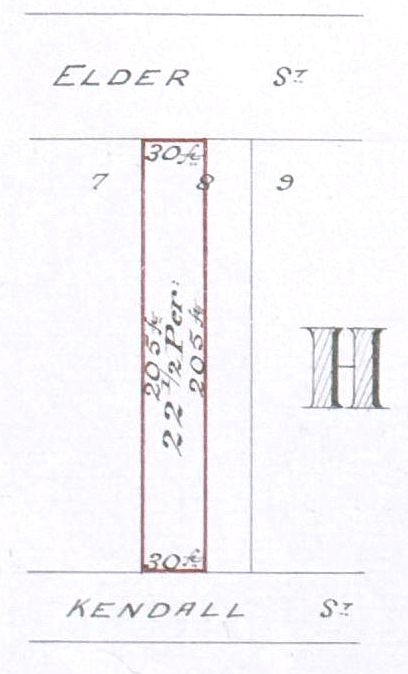
In March 1882 an attempt by George Shaw to transfer the license to Richard Dainty was unsuccessful. The hotel does not appear in the list of license renewals for the years commencing 1 July 1882.
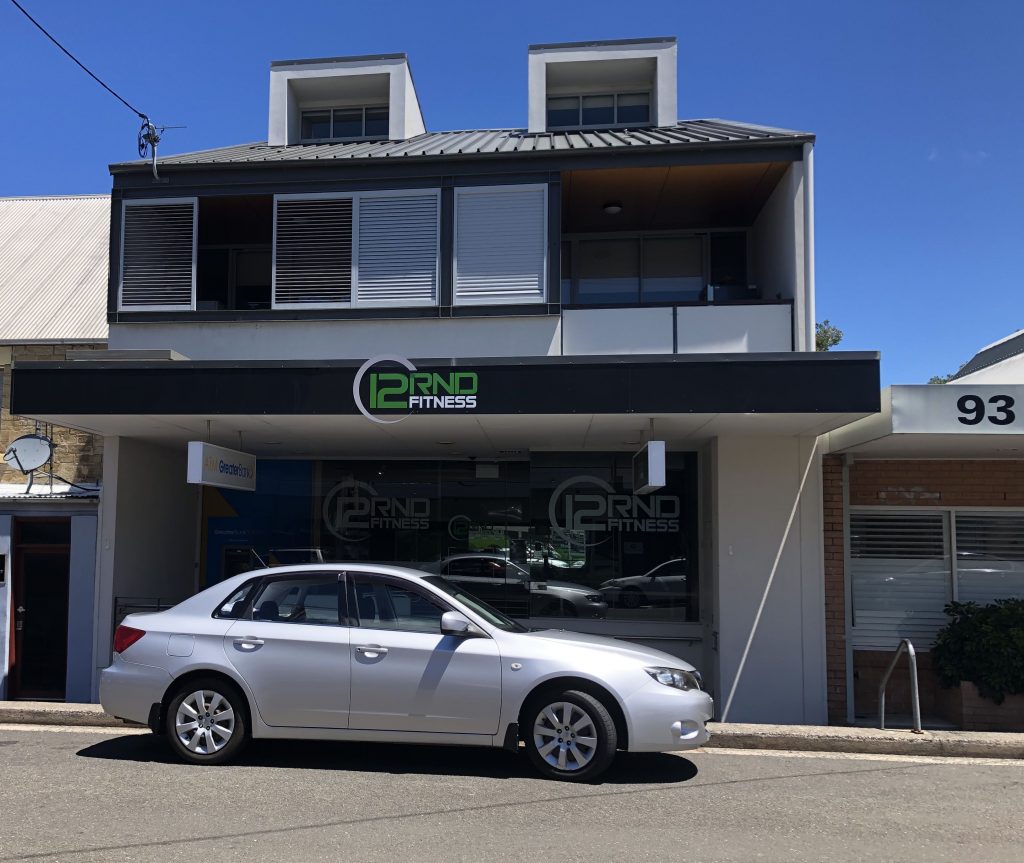
Licensees
- Henry Doherty (July 1878 to June 1879)
- John Donnison (June 1879 to June 1881)
- William Reay (June 1881 to October 1881)
- George Shaw (October 1881 to June 1882)
Northern Star Hotel (1879-1881)
Joseph Phippen purchase Lot 1 of Section A of Lambton township in May 1868. (Vol-Fol 90-68)

In September 1879 he opened a Temperance Hotel on the site located on the north east corner of Dickson and Grainger Streets.

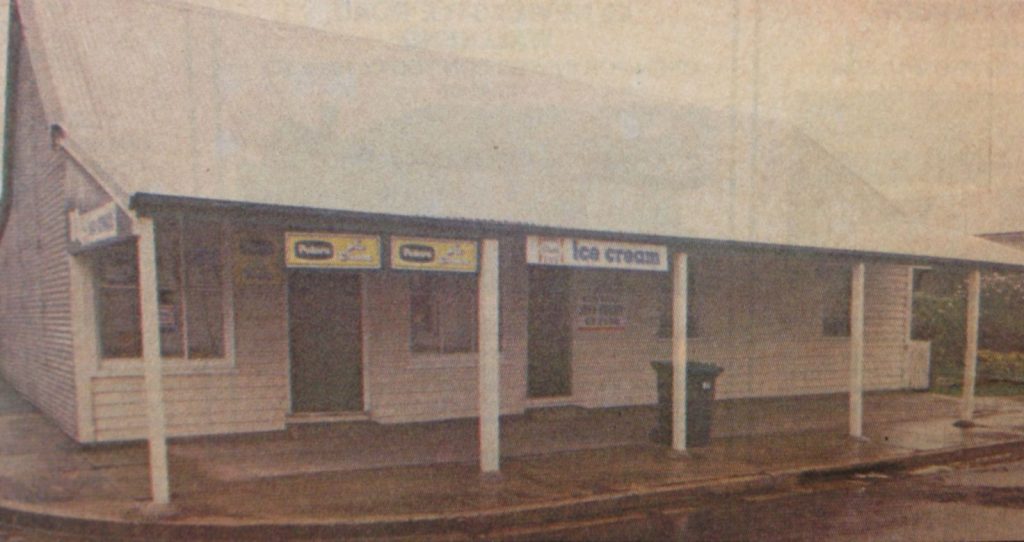
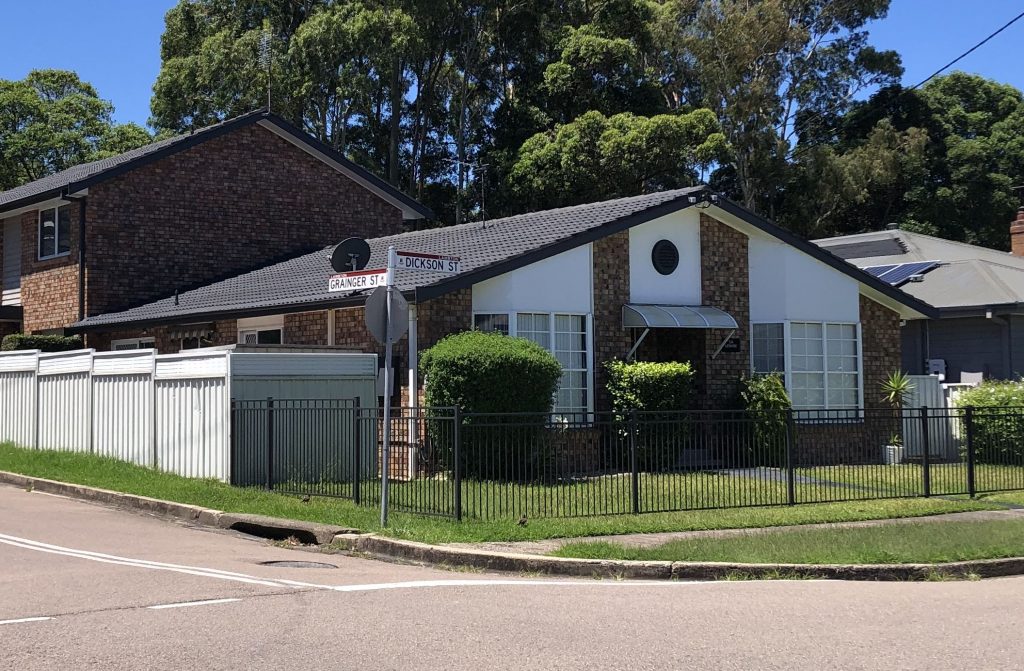
In August 1881, just a few months after John Hutchinson had become the licensee, Joseph Phippen advertised the land and buildings of the Northern Star Hotel for sale. Although the sale never eventuated, there are no more mentions of the Northern Star Hotel after this date.
Licensees
Phippen initially opened the hotel in 1879 as a Temperance Hotel, but the following year acquired a publican’s license.
- Joseph Phippen/Phippins (March 1880 to June 1881)
- John Hutchinson (June 1881 to ????)
Commercial Hotel #1 (1880-1882)
This short lived hotel is not to be confused with the long lived Commercial Hotel that opened in 1888.
In November 1880 Richard Ward, the licensee of the Marquis of Lorne hotel, made application to move his license to premises in Elder Street. The owners of the Marquis of Lorne Hotel (Wood Brothers) objected and the licensing court refused the application. In December 1880 Ward then successfully “applied for a license for a house in Elder-street, to be known as the Commercial Hotel.”
There is very little further information available on the hotel and by April 1882, the Commercial Hotel premises occupied by Ward was advertised for sale, and there is no further mention of the hotel operating after this time. Interestingly, it is the subsequent property sales that allow us to identify the probable location of Ward’s hotel.
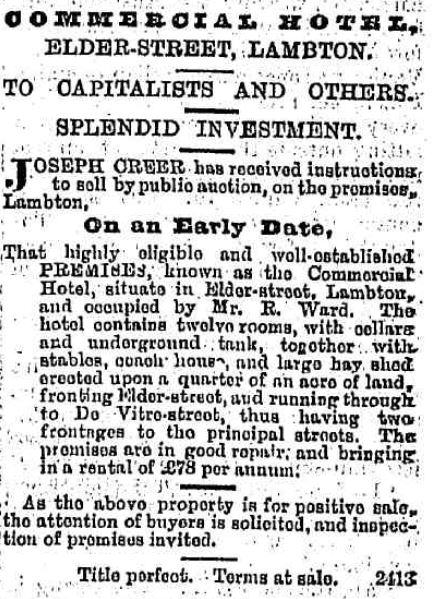
From this advertisement we know that the hotel was on the north side of Elder Street as it was …
“… erected upon a quarter of an acre of land, fronting Elder-street, and running through to De-Vitre-street, thus having two frontages to the principal streets.”
In August 1882 the Newcastle Morning Herald reported that …
“Messrs. W. Lightfoot and Son have removed to Lambton, and commenced business in the premises in Elder-street, lately known as the Commercial Hotel, as grocers, drapers, ironmongers, dealers in colonial produce, etc.”
A few years later, in January 1885, the property was again advertised for sale, split into two allotments.
The first allotment is described as having a frontage to Elder St of 33 feet. Note however that the second allotment has a frontage to Elder St of 18 feet but a frontage to De Vitre St of 35 feet. The difference in frontages can only occur if the block is either wedge shaped, or has an irregular shape. Searching through the chain of land sales on the north side of Elder St shows that there is only one allotment of land sold in this period that has an irregular shape with a frontage to Elder St as described, that being the west half of Lot 5. (The actual frontage is 32 feet 5 inches, not 33 feet – but we all know that real estate agents like to talk things up.)
This site is at address 102-104 Elder St, where Raine & Horne Real Estate was formerly located, and Williams Artisan Bread & Espresso is currently located.
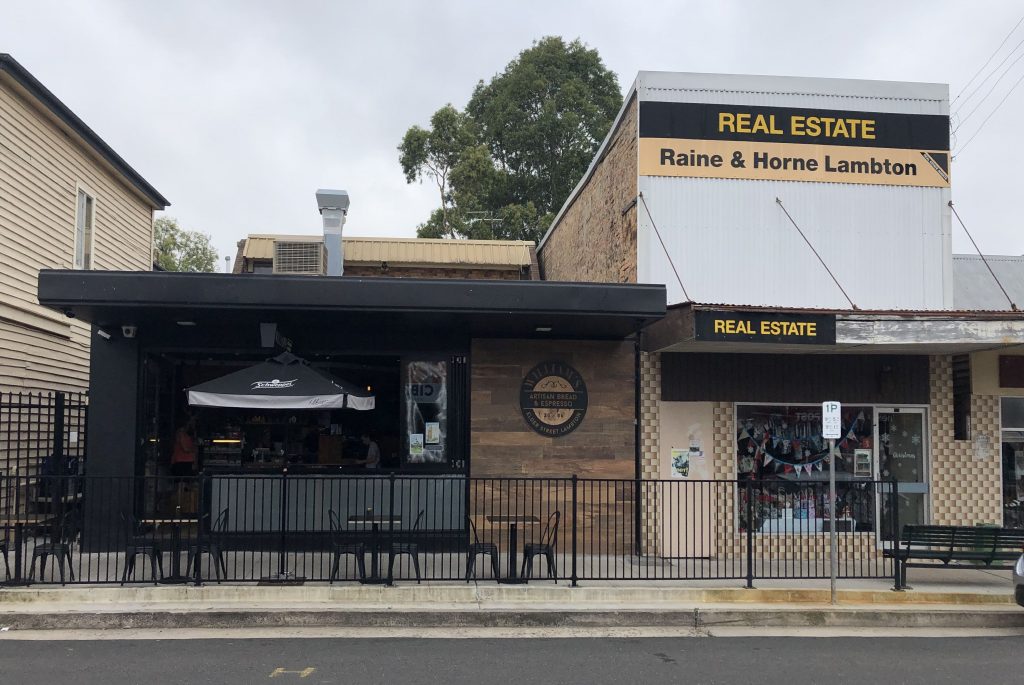
Licensees
- Richard Ward (December 1880 to 1882)
Exchange Hotel (1881-present)
The Exchange Hotel opened in 1881 and was located on the north west corner of Howe and Morehead Streets. Some time around 1986 the hotel was renamed to the “Lambton Park Hotel”.
Henry Johnson purchased the southern half of Lot 10 in Section L of Lambton township in January 1876 (Vol-Fol 249-28).

Johnson erected a small double storey brick hotel building on the site, and in March 1881 was granted a publican’s license. Eli Chadwick subsequently became licensee in 1884.

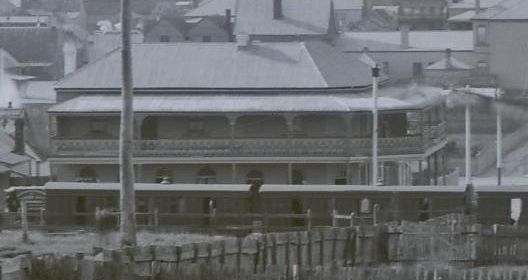
In January 1930 the original hotel building was demolished, and a new building erected, which still stands today.
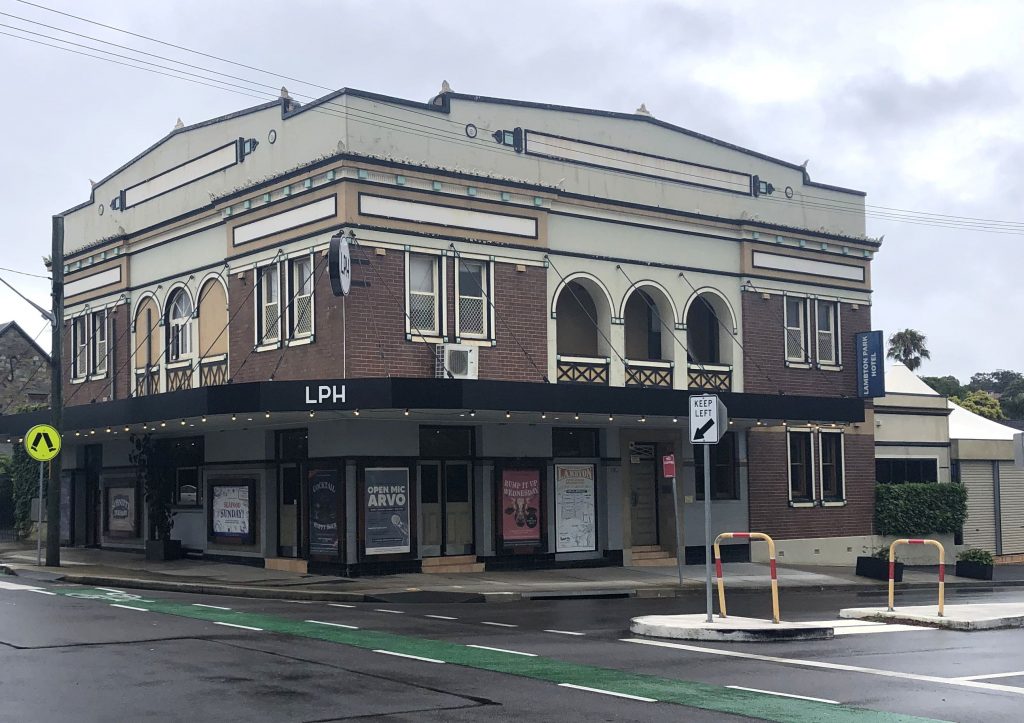
See also
- Exchange Hotel page at ANU Open Research Library, which contains some photographs of the hotel from the 1920s to 1970s.


Licensees
- Henry Johnson (March 1881 to September 1884)
- Eli Chadwick (September 1884 to September 1889)
- Henry Johnson (September 1889 to 1890)
- Joseph Tranter (1890 to April 1896)
- Henry Johnson (April 1896 to October 1897)
- Quinton Hendry (October 1897 to December 1897)
- William (John?) Rutherford (December 1897 to January 1900)
- Isaac Rothery (January 1900 to October 1900)
- Thomas Watson (November 1900 to August 1903)
- William Dent (August 1903 to December 1906, died)
- Mary Dent (1907)
- George O’Donnell (1908 to July 1910)
- John S McNaughton (July 1910 to March 1913)
- Robert Forbes (March 1913 to January 1915)
- Thomas William Bowie (January 1915 to April 1915, died)
- Agnes Bowie (April 1915 to July 1920)
- William Mulcahy (July 1920 to October 1920)
- Bernard Grimes (October 1920 to March 1925)
- Edward Hill (March 1925 to December 1925, died)
- Sarah Caroline Hill (December 1925 to March 1926)
- John Donald Curran (March 1926 to December 1926)
- Jeremiah John Dwyer (December 1926 to January 1928)
- William Eugene McCarthy (January 1928 to September 1929)
- William Charles Keighran (September 1929 to November 1936)
- Harry B Carroll (November 1936 to June 1945, died)
- Mrs A E Carroll (June 1945 to February 1955)
- Claude Henry Wright (February 1955 to July 1962)
- Geoffrey Liddiard Newton ((July 1962 to September 1964)
- Brian Palmer Jones (September 1964 to November 1967)
- Allan James Reay (November 1967 to March 1968)
- Athol Francis Lewis (March 1968 to June 1971)
- Mrs Melba May Morris (June 1971 to May 1976)
- Mrs Patricia Abraham (May 1976 to October 1978)
- Robert George Jenkins (October 1980 to August 1983)
- John Brown (August 1983 to May 1984)
- Geoffrey Alexander Stewart (May 1984 to ????)
- ?
Marquis of Midlothian (1885-1892)
The hotel was located on the north east corner of Ralph and Robert Streets in Jesmond. The hotel building still exists today, and is a private residence.
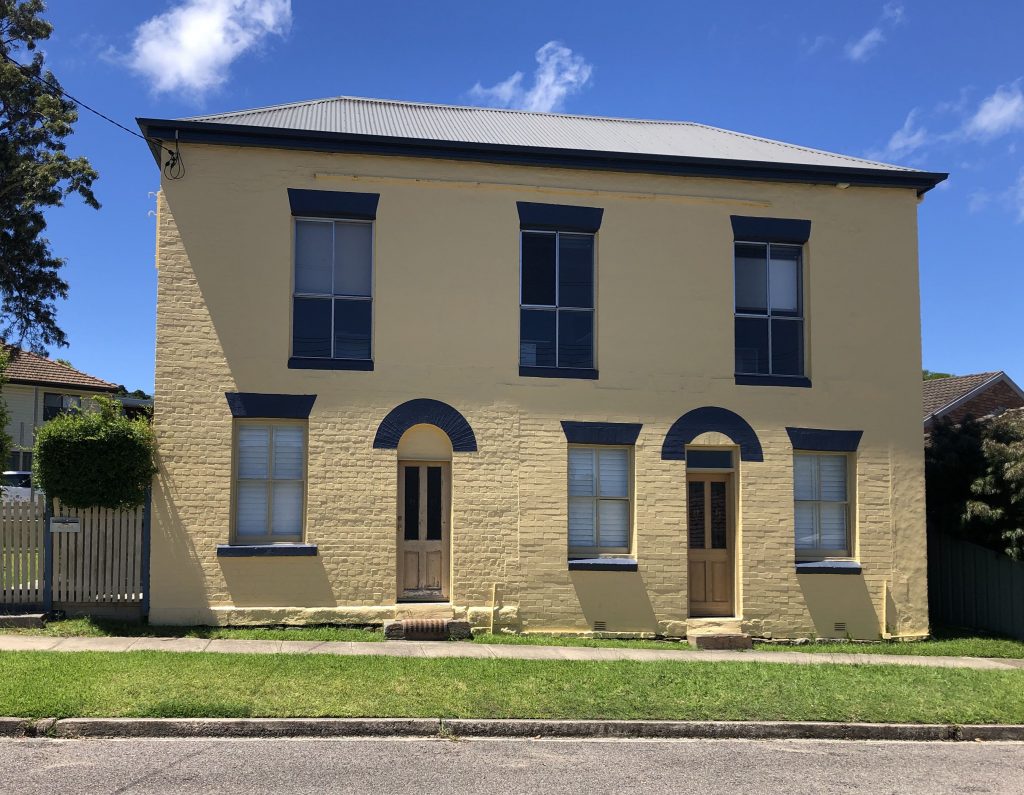
In May 1876 George Smith purchased Lot 10 of Section C in the private township of Jesmond. (Vol-Fol 266-98)
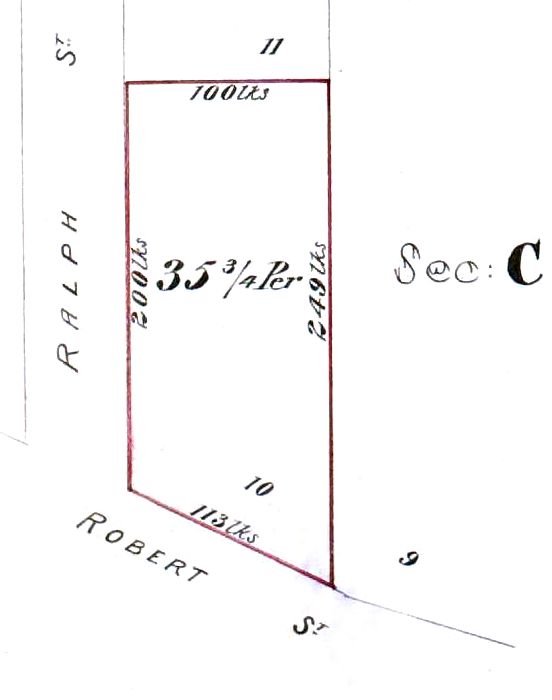
Within a few months, the newspaper reported that …
“Mr. George Smith is erecting a splendid store and dwelling-house. The building is two stories, and composed of brick, containing about ten rooms in all. It is now nearly completed, excepting the doors and windows and inside fittings. When finished, it will be one of the most imposing buildings in the district.”
Newcastle Morning Herald and Miners’ Advocate, 11 August 1876.
However it seems that Smith (or his building contractor) wasn’t careful about where the Lot boundary was, and part of the building encroached into the then vacant and unsold adjoining Lot 9. In 1883 when James Mitchell purchased Lot 10 from George Smith, he also needed to purchase a little triangular wedge of Lot 9.
The encroachment of the building over the original Lot boundary can be graphically seen in the Title Certificate of a later sale of Lot 9.
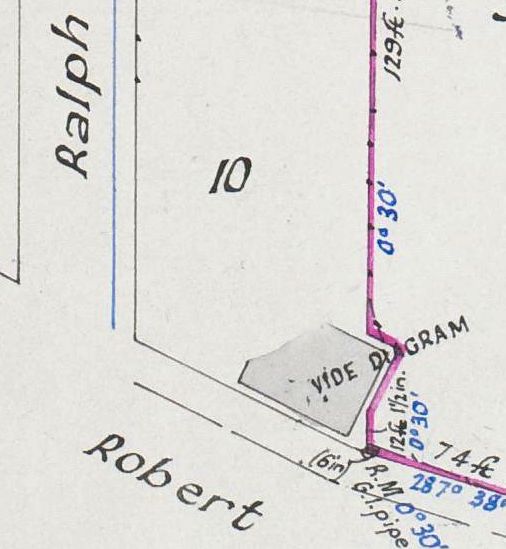
James Mitchell having acquired the land and building in 1883 “expended a large amount of money on the house” and applied for a publican’s license in April 1885. Mr Perrott, the magistrate at the licensing court refused the application “on the ground that the reasonable requirements of the place did not justify the granting of it”, adding “the spending of a lot of money on a house did not entitle it to be licensed.”
It is not clear what (if anything) changed, but six months later in October 1885, Mitchell submitted the application again before the same licensing magistrate, but this time the application was granted, and the Marquis of Midlothian hotel was opened.
James Mitchell remained as publican until November 1891, when the license was transferred to Bartholomew Davison. Davison renewed the license in November 1892, but there is no mention of the hotel operating after this time. It is probable that it had ceased trading by February 1893 when the property was advertised for sale. This was but one of many unsuccessful attempts by Mitchell to sell his property in June 1888, April 1891, February 1893 and January 1900.
In April 1902, Thomas Henry Armstrong applied to re-open the hotel under the new name of the “Sportsmans’ Arms”. After hearing arguments for and against the granting of a license, the Newcastle Licensing Court reached their decision …
“The application was refused on the grounds that the requirements of the place did not justify a license.”
The property was sold later that year on 23 August 1902 to John Henry Mitchell. In 1929 when there was a proposal for a new hotel in Jesmond, residents opposed to the application recalled Jesmond hotels of bygone days …
“The building which was known as Mitchell’s Hotel is still intact, and is occupied as a private dwelling. Mitchell’s Hotel was regarded as a sporting place, and could boast having one of the best ball alleys in the district. A large crowd usually assembled on what was recognised as the miners’ pay-Saturdays, and witnessed many exciting handball matches and handicaps, which were commenced early in the morning and continued until nightfall.”
Newcastle Morning Herald and Miners’ Advocate, 17 September 1929.
Licensees
- James Mitchell (October 1885 to November 1891)
- Bartholomew Davison/Davidson (November 1891 to 1892)
Commercial Hotel #2 (1888-2018)
The Commercial Hotel was located on the south west corner of Elder and Grainger Streets. At various times it was also known as Snake Gully Hotel, Amos Hotel, and Bar 121.

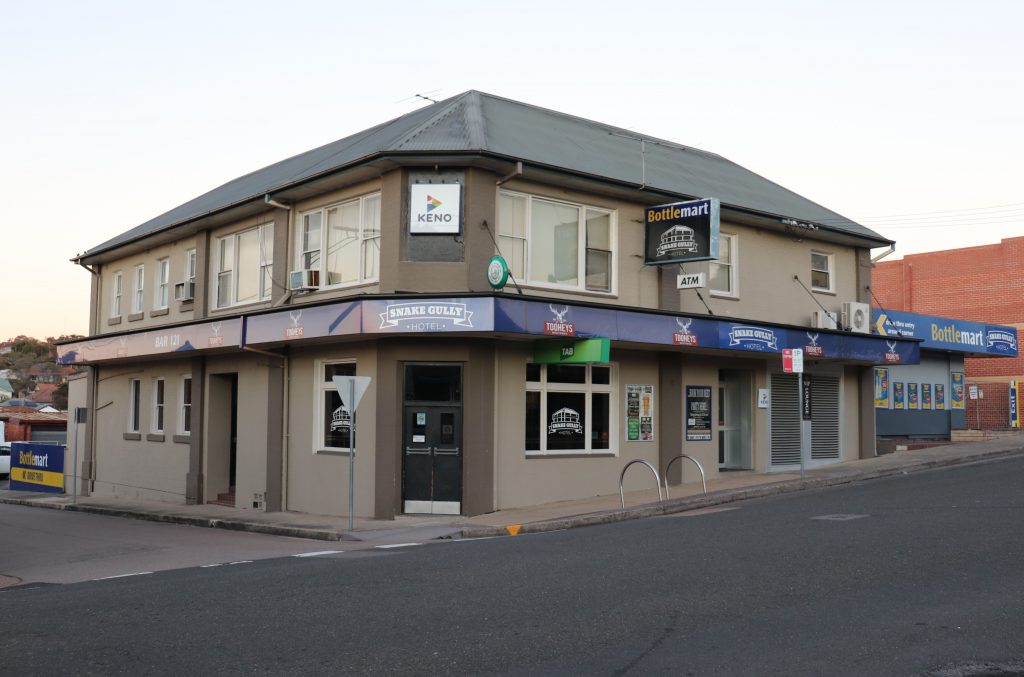
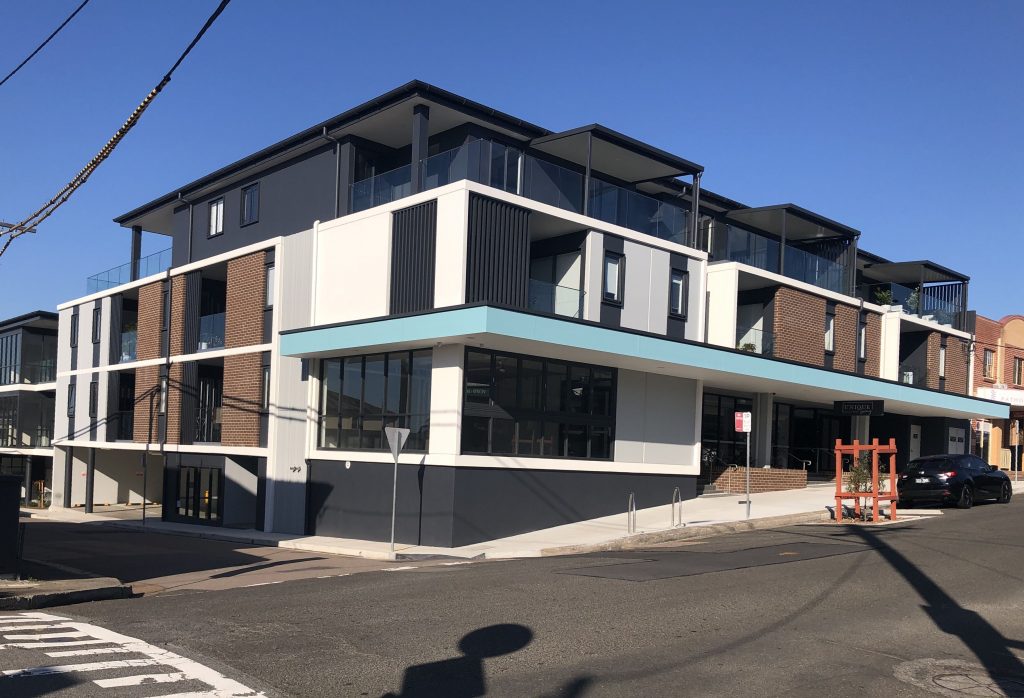
For further details see my December 2018 article on the Commercial Hotel.
See also
- Commercial Hotel page and Amos Hotel page at ANU Open Research Library, which contains some photographs of the hotel from the 1920s to 1970s.
Licensees
- William Brown (July 1888 to July 1889)
- John Sample (July 1889 to 1893)
- Joseph Oldham (1894 to October 1895)
- John W Buckley (October 1895 to 1896)
- Ann Jane Buckley (1897 to April 1898)
- Thomas Liddle (April 1898 to March 1899)
- David Clement Harvey (March 1899 to February 1900)
- William Rutherford (1900)
- George Smith (1901 to December 1912)
- Thomas J Byrne (January 1913 to May 1914)
- Michael Ambrose Lowry (May 1914 to September 1916)
- James Thompson (October 1916 to September 1918)
- Patrick Joseph Waldron (September 1918 to November 1918)
- John Peel (November 1918 to February 1919)
- Emma Ashman (February 1919 to July 1919)
- James M Britt (1919)
- Walter James Barrington (September 1919 to December 1920)
- Stephen Thomas Shipley (December 1920 to 1921)
- S Bryant (July 1922 to November 1922)
- E R Bennett (November 1922 to March 1923)
- G Fuller (March 1923 to September 1924)
- Eva Shaw-Smith (September 1924 to August 1925)
- Horace James Pick (August 1925 to December 1928)
- Edward Henry Naughten/Naughton (December 1928 to April 1936)
- Edward Thomas Shipley (April 1936 to February 1937)
- James Alexander Johnston (February 1937 to August 1937)
- Leslie Alvan Radnidge (August 1937 to December 1937)
- Sidney John Bookless (December 1937 to August 1938)
- Frederick Hector (August 1938 to December 1941)
- Roy Townshend (December 1941 to July 1943)
- Leslie Errol Doohan (July 1943 to October 1943)
- Louise May Egan (October 1943 to December 1946)
- Herbert Walter Harris (December 1946 to September 1960)
- David John Amos (September 1960 to ????)
- ??
Reservoir Hotel (1888-1921)
The Reservoir Hotel was located on the north east corner of Newcastle Rd and George St. The hotel building still exists, and is now a private residence.
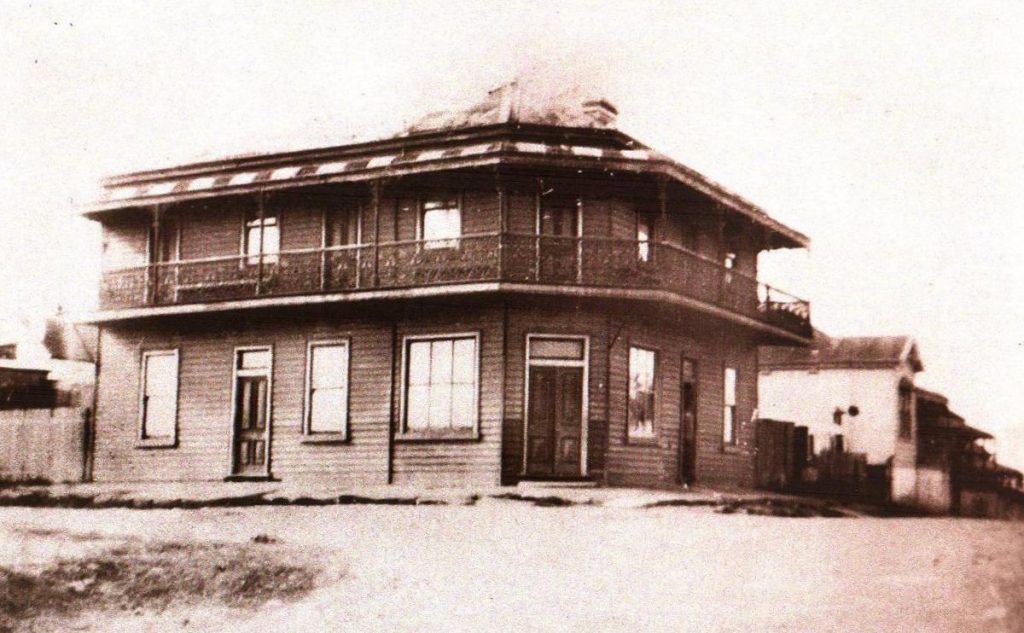
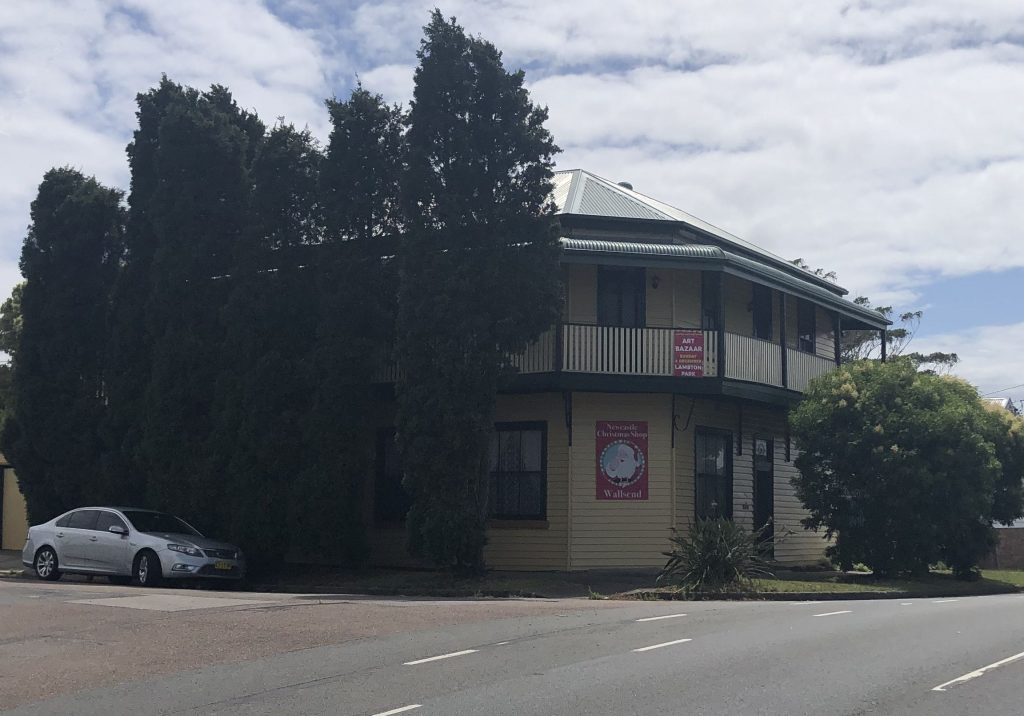
For further details, see my January 2021 article on the Reservoir Hotel.
Licensees
- Jacob Dent (1888 to 1892)
- William Rutherford (1893 to 1897)
- John Cox (1898 to 1900)
- Ellen Jane Cox, widow of John Cox (1900 to June 1902)
- William Newell (June 1902 to June 1903)
- Thomas Weaver (June 1903 to May 1904)
- Joseph Brindley (May 1904 to 1905)
- William H North (1906 to 1910)
- Thomas Owens (1911 to 1912)
- B D Holloway (1913)
- Thomas Mordue (1913 to March 1917)
- John McKenzie (March 1917 to 1918)
- Mary Etta Graham (1919 to 1920)
- John Baptist Beisler (1921)

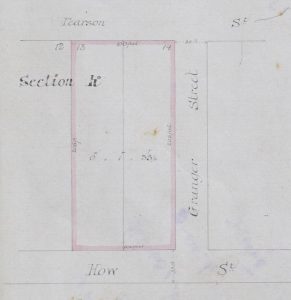


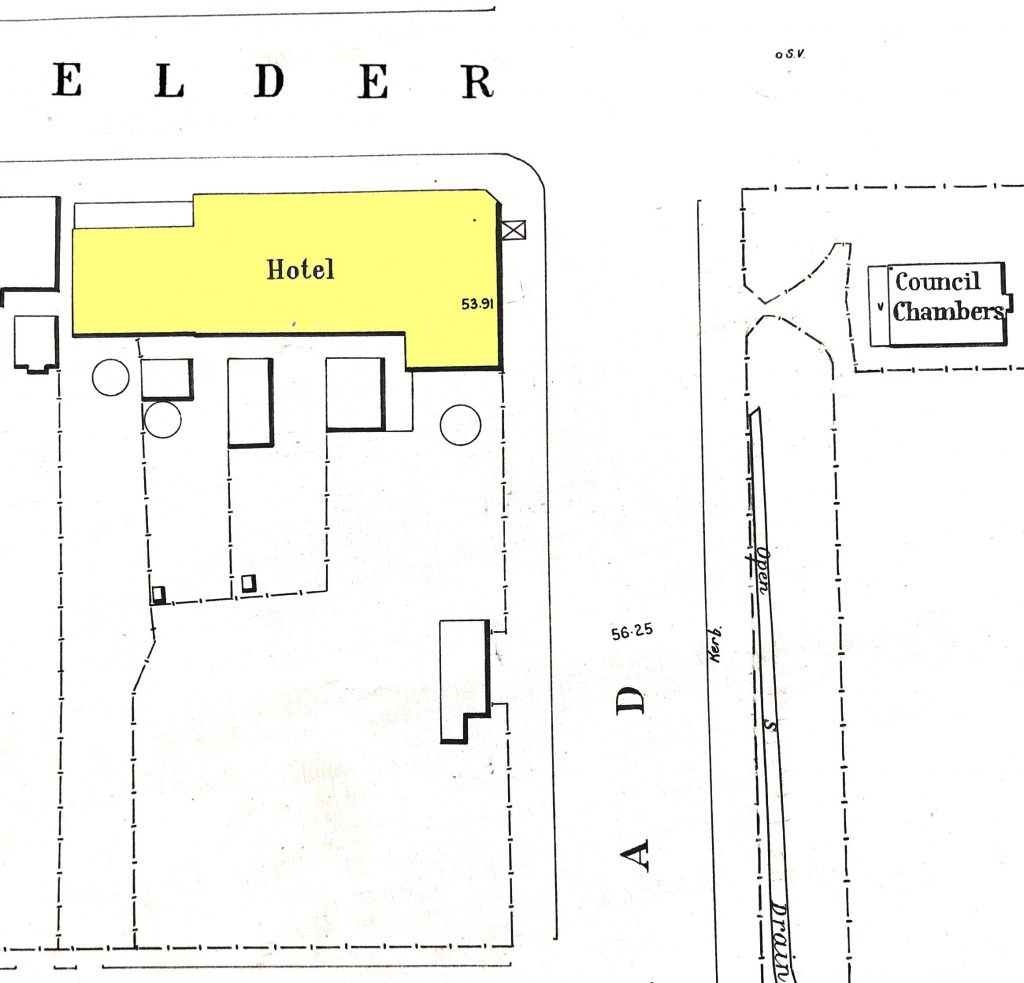




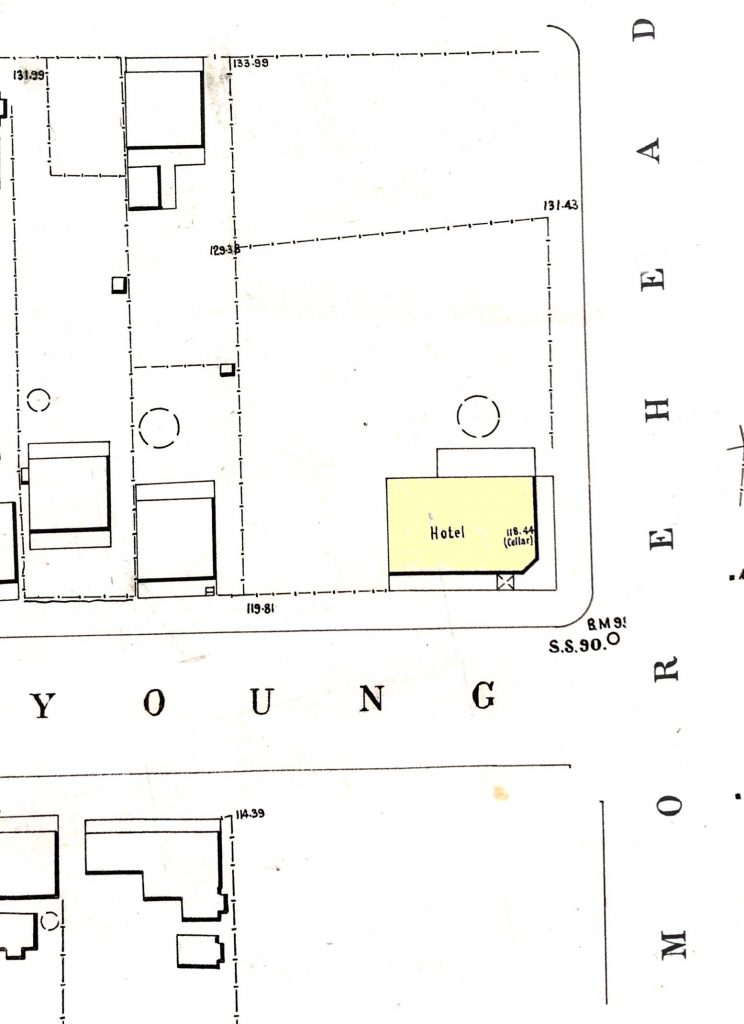



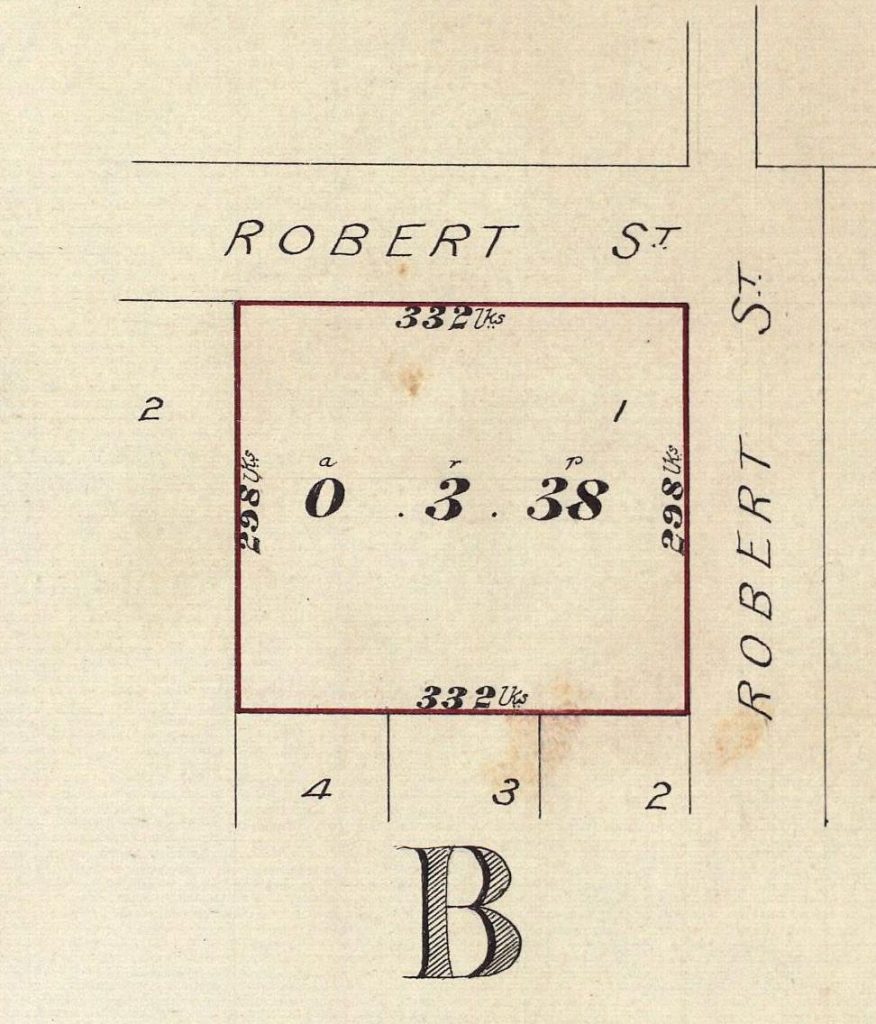
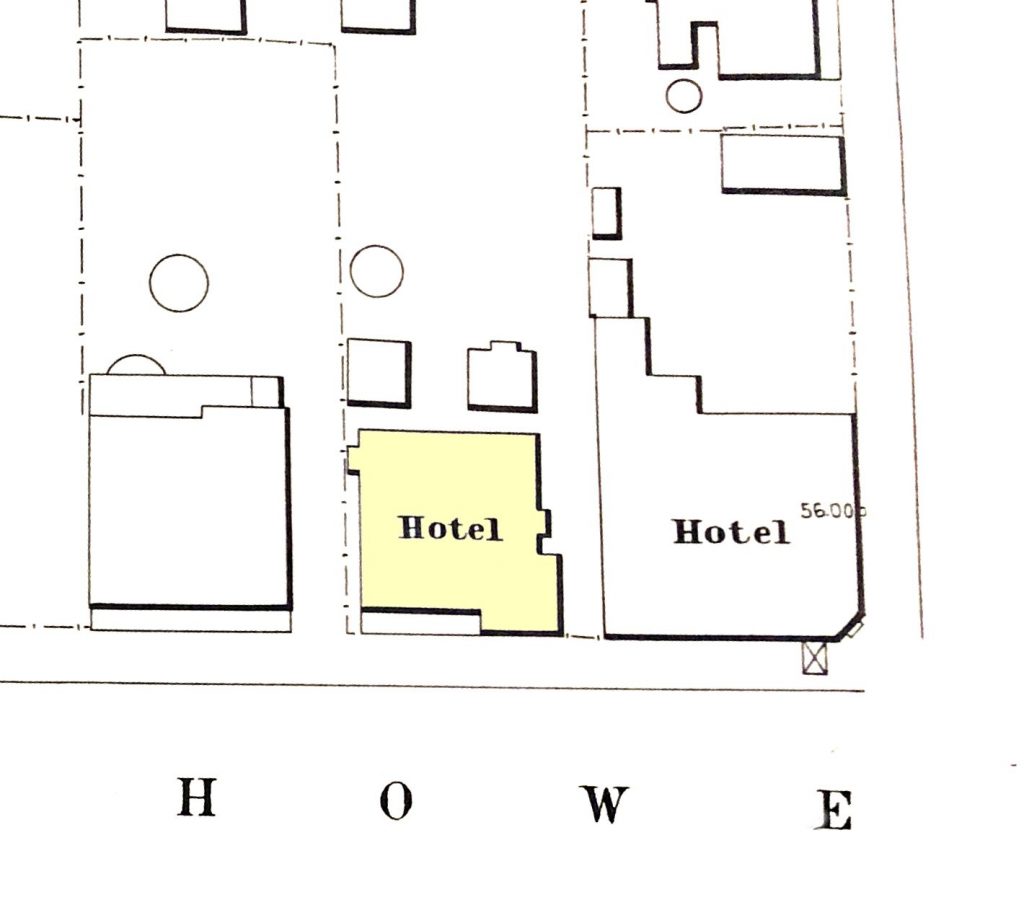
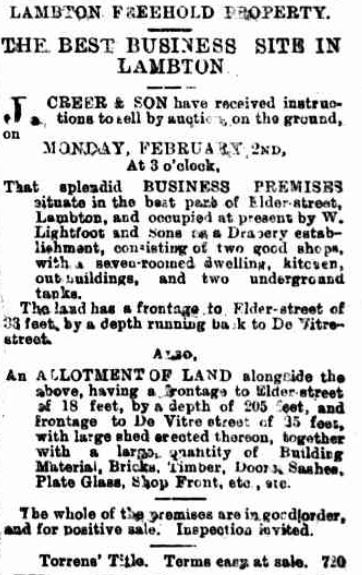
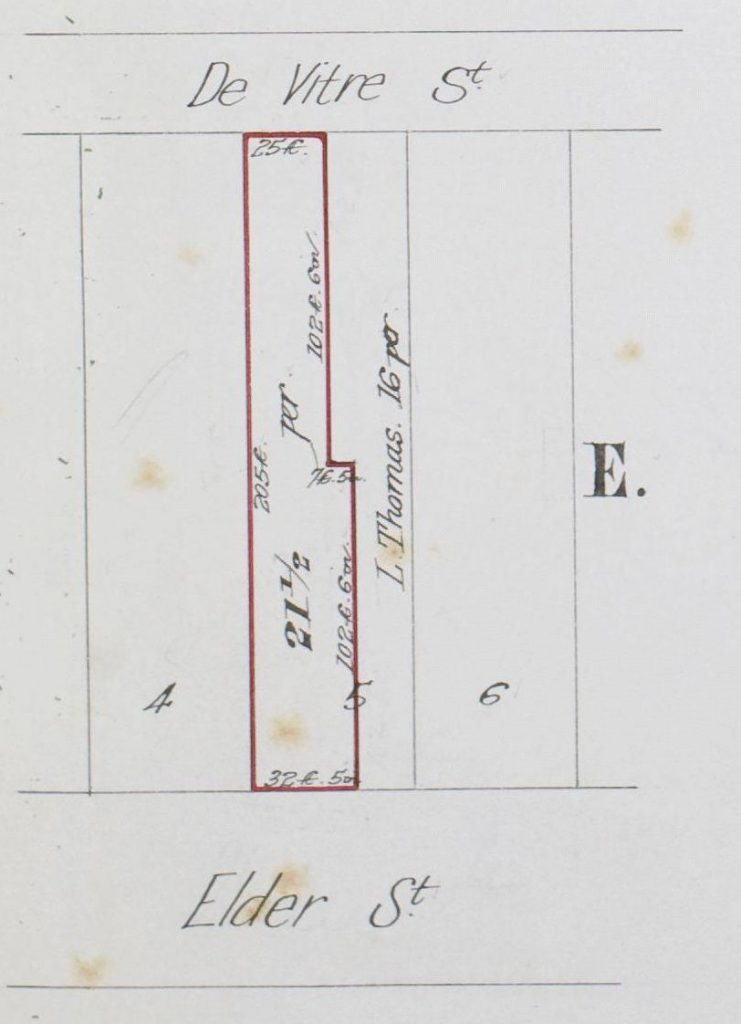


My 4x Great Grandfather, John Dent, was the first licensee of the Northumberland Hotel between 1866 to 1873. It was great to stumble across this fantastic article while researching John and the Northumberland Hotel in general.
Thank you. I live on the corner of Pearson and Grainger. Lancashire hotel.
Hi Lachlan,
Really great work. I was the last owner of the Marquis of Midlothian Hotel until recently and the person that carried out the extensive renovations to the building. It is now a disability assistance business. I really enjoyed living there for about 12 years.
Incredible work, but there is a minor typo under the Miners’ Arms Hotel. The deed for Henry Johnson’s purchase of lot 8 should be Vol 164 Fol 25, not Vol 154 Fol 25.
Thanks for that. I’ve fixed it now. Pointing out of typos and suggested corrections are warmly welcomed on this site.
This is fabulous research. Obviously a labour of love.
Thanks for your kind words.
Pingback: Hotels of Lambton | A bit of this, a bit of that